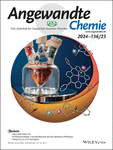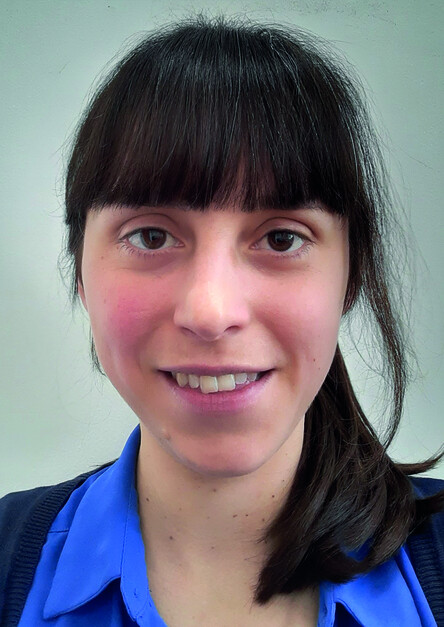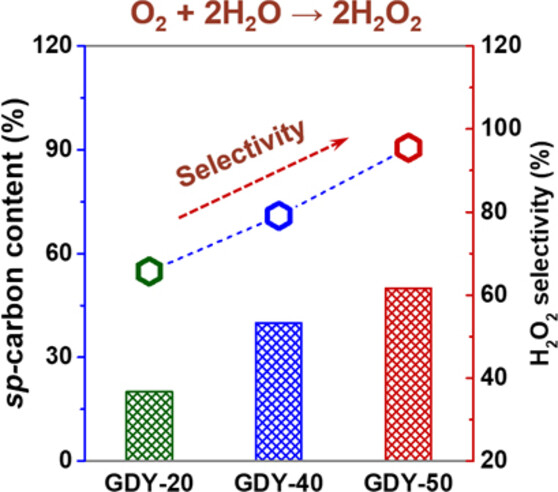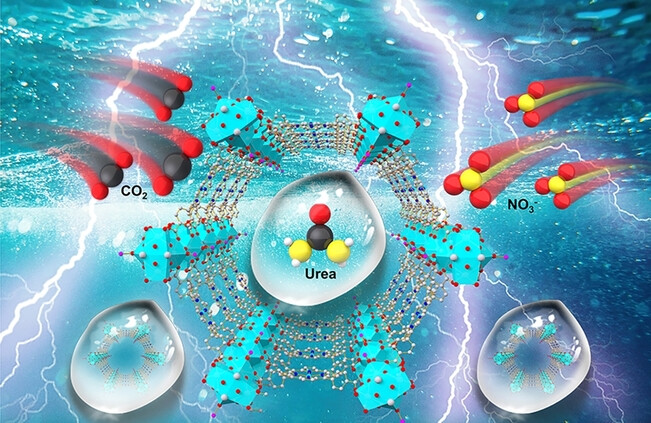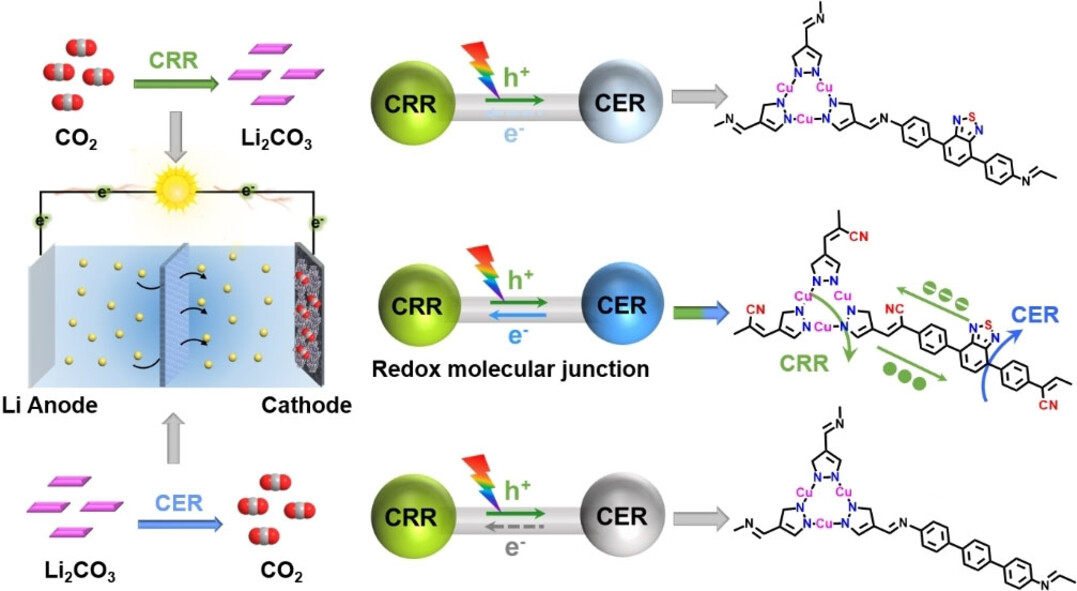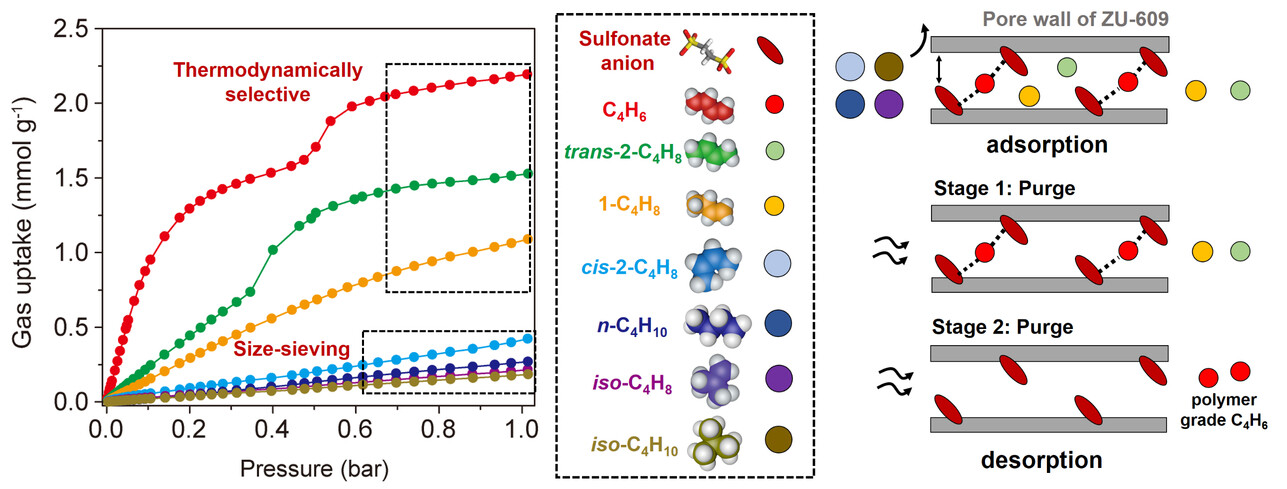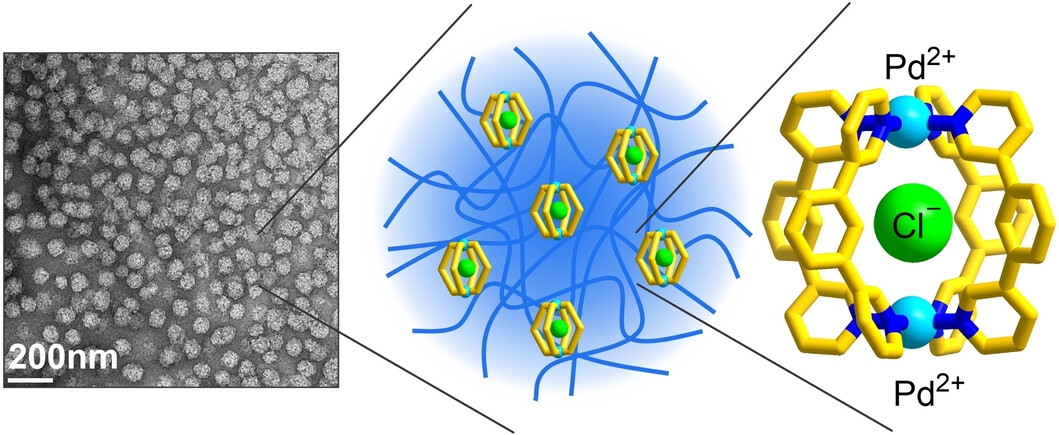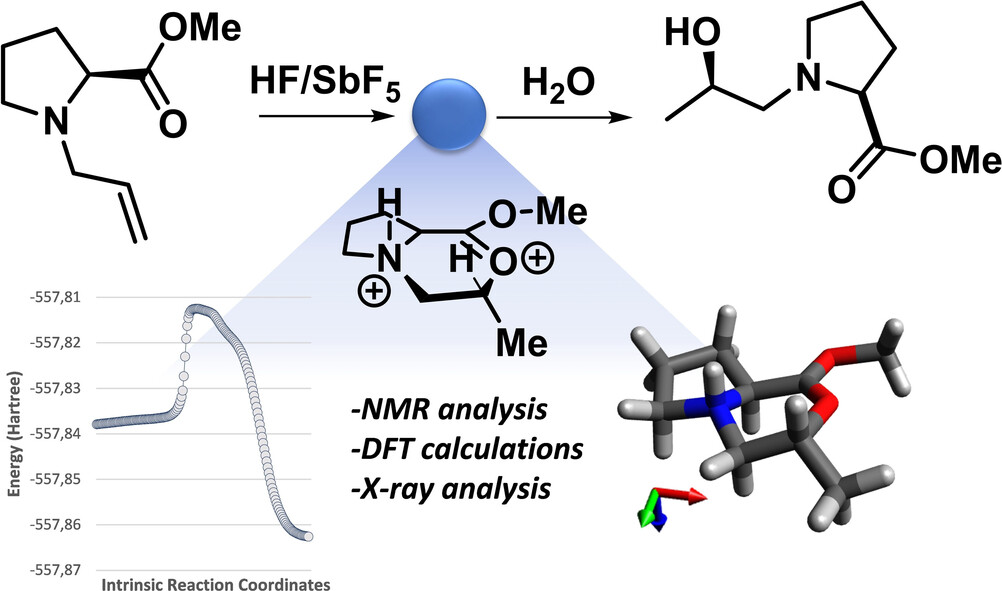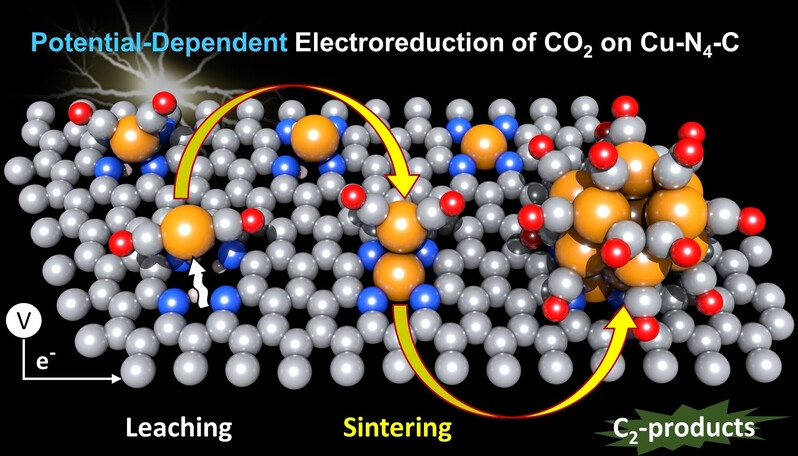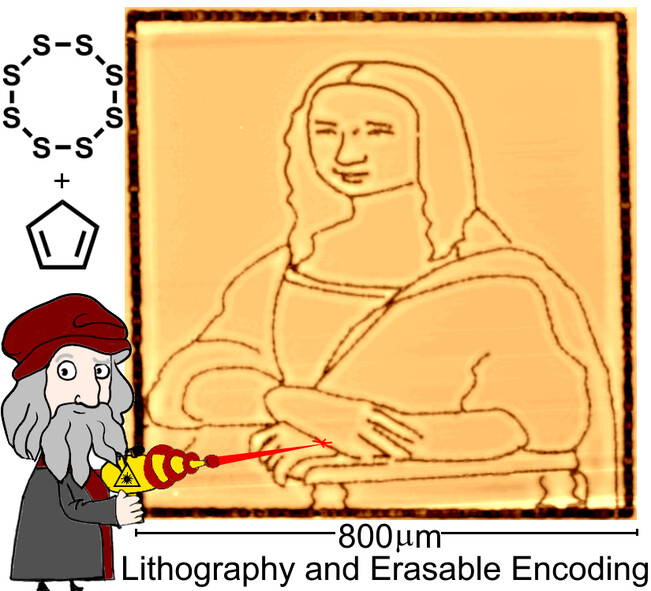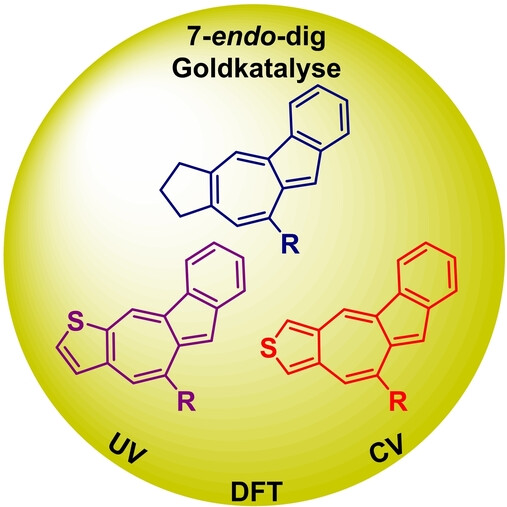Journal list menu
Export Citations
Download PDFs
Covers
Titelbild: An Electrocatalytic Cascade Reaction for the Synthesis of Ketones Using CO2 as a CO Surrogate (Angew. Chem. 23/2024)
- First Published: 23 May 2024
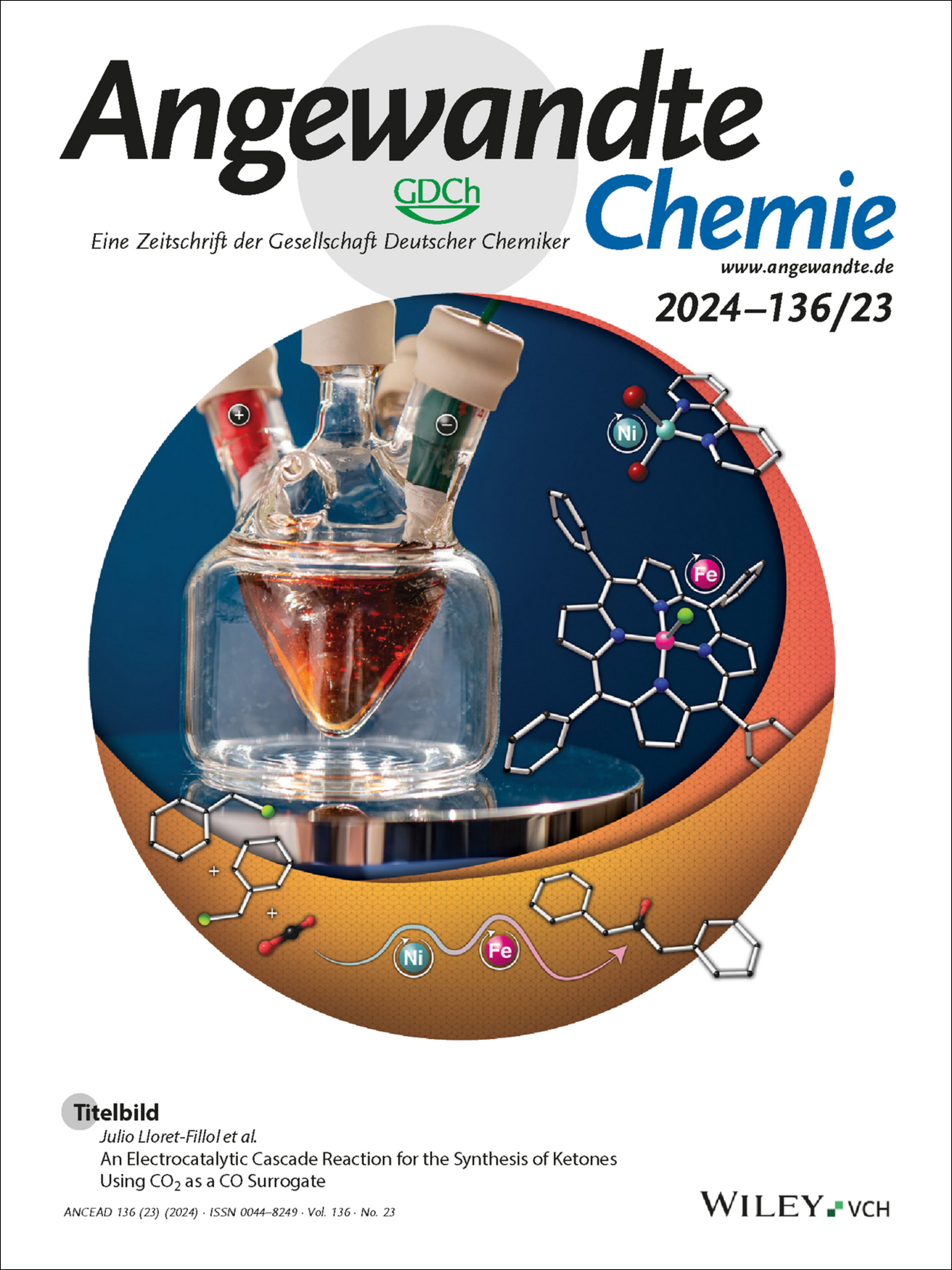
A one-pot electrocatalytic cell featuring a nickel foam electrode as the cathode and a non-sacrificial carbon electrode as the anode is depicted on the cover. In their Research Article (e202403674), Julio Lloret-Fillol et al. describe a synergistic cascade catalysis strategy. This method employs two earth-abundant metallocatalysts—iron tetraphenylporphyrin and nickel bipyridine—to efficiently synthesize symmetric ketones from CO2 and alkyl chlorides with high yields.
Innenrücktitelbild: Cage-To-Cage Transformations in Self-Assembled Coordination Cages Using “Acid/Base” or “Guest Binding-Induced Strain” as Stimuli (Angew. Chem. 23/2024)
- First Published: 23 May 2024

A cyclically operated three-state supramolecular switching phenomenon is demonstrated by Dillip Kumar Chand et al. (Molecular Architecture Laboratory, IIT Madras) in their Research Article (e202403711). The states A and B represented by guest-bound Pd2L4-type coordination cages are interconvertible upon addition of suitable base/acid. These two states are displayed on the cover against the background of Kashmir Tulip garden. Cationic pyrylium units crafted in a coordination cage are mapped with the polycyclic pyrylium pigments of tulips.
Rücktitelbild: Synthesis, Structures and Properties of Trioxa[9]circulene and Diepoxycyclononatrinaphthalene (Angew. Chem. 23/2024)
- First Published: 23 May 2024
![Rücktitelbild: Synthesis, Structures and Properties of Trioxa[9]circulene and Diepoxycyclononatrinaphthalene (Angew. Chem. 23/2024) Volume 136 Issue 23, 2024](/cms/asset/629bd59a-4a9b-4757-912c-a2204aacda34/ange202407861-toc-0001-m.jpg)
A 9-membered ring is incorporated into a saddle-shaped π-skeleton: In their Research Article (e202402756), Qian Miao et al. report the synthesis of trioxa[9]circulene through intramolecular oxidative coupling of dimethoxydioxa[8]helicene. In the crystals, molecules of trioxa[9]circulene stack in a column with remarkable π–π overlap, resembling the stacking pattern of saddle-shaped potato chips. Dimethoxydioxa[8]helicene exhibits high absorption and luminescence dissymmetry factors on the order of 10−2.
Graphisches Inhaltsverzeichnis
Berichtigungen
Announcement
Classifieds: Jobs and Awards, Products and Services
- First Published: 23 May 2024
Are you looking for a (new) job? Do you know someone who deserves an award? Are you trying to find a product or service to make your work more efficient? Our partners can help.
Introducing …
Aufsätze
Molecular Motors
Molecular Ratchets and Kinetic Asymmetry: Giving Chemistry Direction
- First Published: 03 April 2024
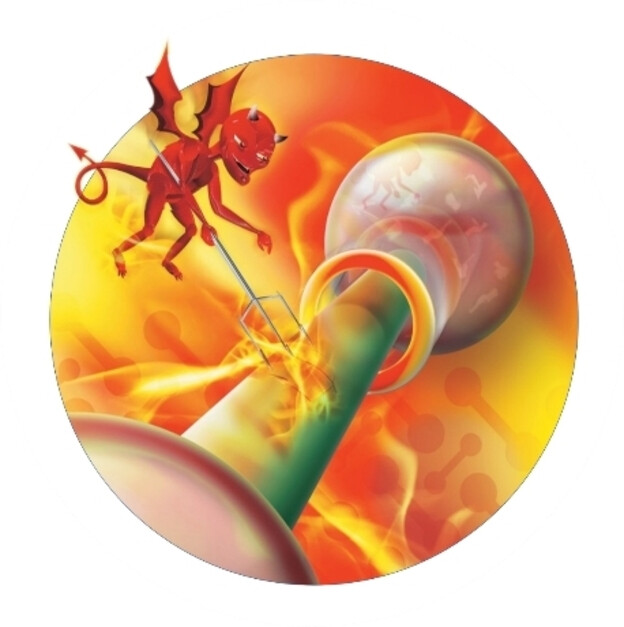
Ratcheting is the mechanism by which stochastic molecular dynamics, and other random exchange processes in chemistry, can be directionally biased and driven away from equilibrium. In this Review we discuss the recognition, invention and development of molecular ratchets and kinetic asymmetry, which underpins it. We explain the design principles for different types of ratchet and energy sources, and outline some current challenges and opportunities for the future.
CO2 Utilization
Rational Design of Local Reaction Environment for Electrocatalytic Conversion of CO2 into Multicarbon Products
- First Published: 04 April 2024
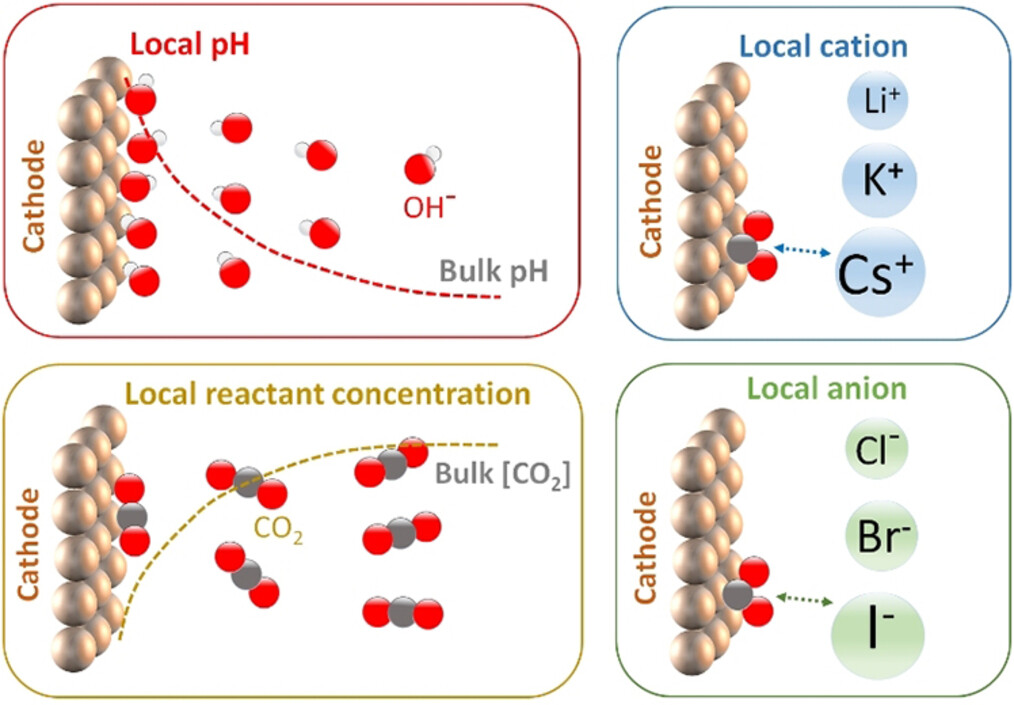
Beyond engineering the catalyst, rational design of the local reaction environment near the catalyst surface, including local pH, the choice of the species of cations and anions as well as local reactant/intermediate concentrations, also acts as an effective approach for further improving the catalytic performance of CO2 reduction to valuable multicarbon products.
Forschungsartikel
Lithium Metal Batteries
Interphase Engineering via Solvent Molecule Chemistry for Stable Lithium Metal Batteries
- First Published: 27 March 2024
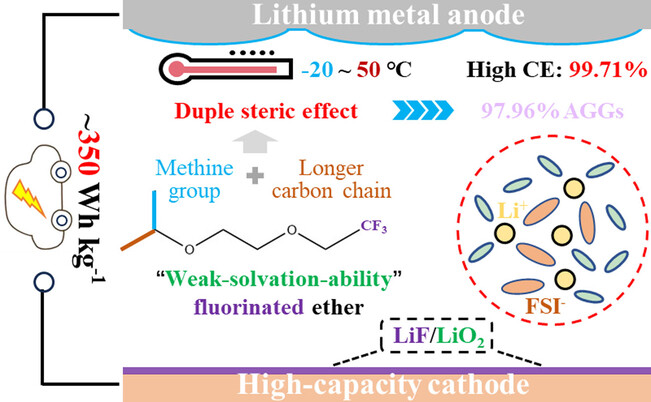
Fluorinated ethers are synthesized with weak-solvation ability owing to the duple steric effect derived from the designed longer carbon chain and methine group. The electrolyte solvation structure rich in AGGs (97.96 %) renders modified interphase and remarkable CE of 99.71 % as well as high CE of 98.56 % even at −20 °C. It also renders stable performance of pouch Li-S battery.
Cross-coupling Reactions
Anti-Selective Carbosilylation: Nickel-Catalyzed Multicomponent Reaction of Solid Me3SiZnI
- First Published: 28 March 2024

This study presents a unique approach for the selective synthesis of stereodefined trisubstituted vinylsilanes via the anti-selective addition of a novel solid Me3SiZnI to terminal alkynes. An equilibrium exists between the intermediate syn- and anti-adducts, where the anti-selectivity is determined by the larger barrier at the single electron reduction of alkyl halides and the thermodynamic stability of the Ni(III) adduct.
H2O2 Production
Electronic Metal-Support Interactions Boost *OOH Intermediate Generation in Cu/In2Se3 for Electrochemical H2O2 Production
- First Published: 02 April 2024
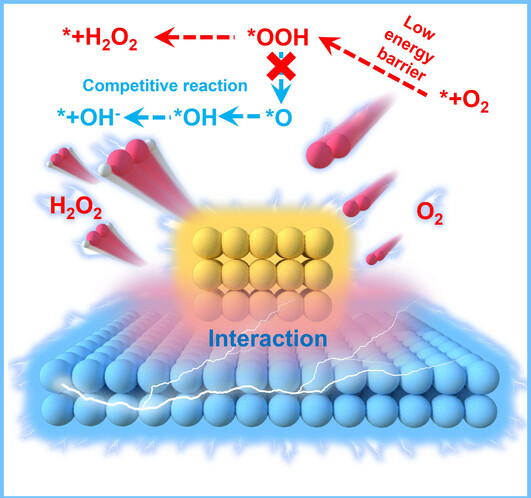
The strong electronic metal–support interactions between Cu and In2Se3 cause the charge rearrangement, which is conducive to *OOH intermediate generation. The introduction of Cu not only reduces the energy of the 2-electron oxygen reduction intermediate but also inhibits the 4-electron oxygen reduction reaction, which facilitates the efficient production of H2O2.
Metals in Medicine | Hot Paper
A Photodynamic and Photochemotherapeutic Platinum-Iridium Charge-Transfer Conjugate for Anticancer Therapy
- First Published: 24 April 2024
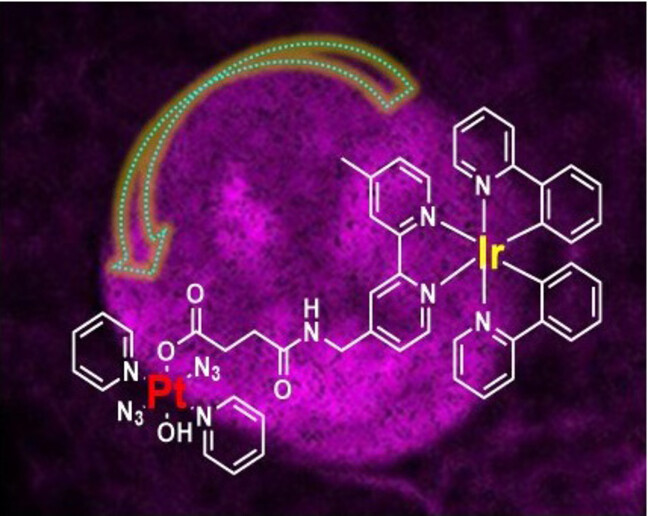
Charge transfer between donor Ir(III) and acceptor Pt(IV) introduces synergistic activity for these photodynamic and phototherapeutic centres, 1O2 and radical generation, higher Pt accumulation, and damages cell nuclei and releases chromosomes. X-ray fluorescence revealed a broad distribution in cells, with Ir localised in small compartments, some as a cleaved fragment.
Cancer Therapy
Activable Nano-Immunomodulator Assembled from π-Extended Naphthalenediimide for Precision Photothermal Immunotherapy
- First Published: 04 April 2024
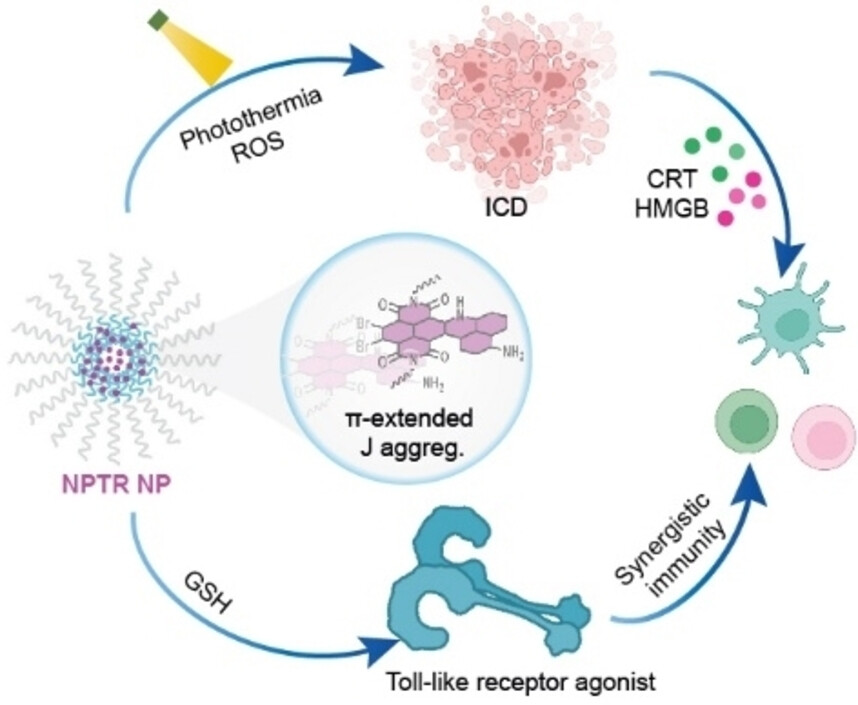
A nano-immunomodulator consisting of glutathione activable resiquimod and π-extended NIR-absorbing system is engineered for spatiotemporally controlled photothermal immunotherapy. The synergistic immunity and photothermal effect lead to complete tumor ablation against both primary and distal tumors, presenting a generic strategy for engineering nano-immunomodulator to achieve a precise regulation of photothermal immunotherapy.
Polaritonic Chemistry
Direct Observation of Polaritonic Chemistry by Nuclear Magnetic Resonance Spectroscopy
- First Published: 07 April 2024
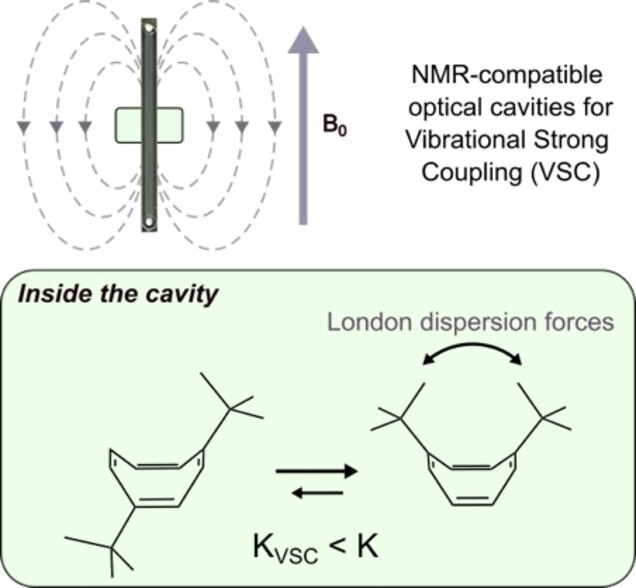
New Fabry-Perot optical cavities were developed that enable studying Vibrational Strong Coupling (VSC) by Nuclear Magnetic Resonance (NMR) spectroscopy. We demonstrate that the London dispersion-driven conformational equilibrium of a molecular balance is altered when the C−H stretching vibration is strongly coupled to the cavity. Unexpectedly, VSC does not substantially affect molecular electron density distributions which has profound implications for the possible mechanisms at play in polaritonic chemistry.
Nucleic Acids
Universal crRNA Acylation Strategy for Robust Photo-Initiated One-Pot CRISPR–Cas12a Nucleic Acid Diagnostics
- First Published: 02 April 2024
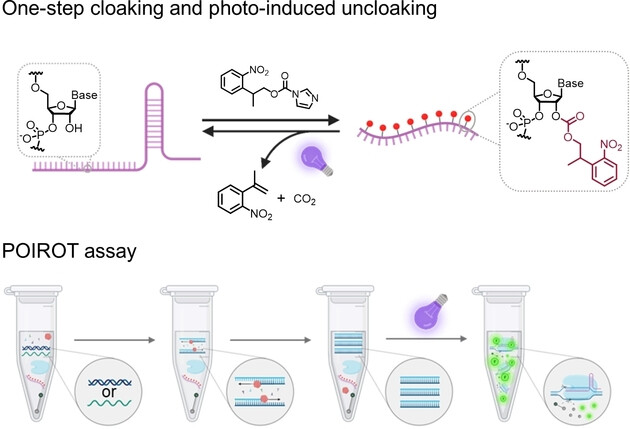
A universal and accessible acylation strategy for fabricating cloaked crRNA to realize photo-initiated one-pot CRISPR–Cas12a assays regardless of the crRNA sequences has been developed. This innovative acylation strategy can bring great advantages and convenience in photo-controlled CRISPR technologies, highlighting their potential in genomic editing, disease therapy, and cell imaging.
H2O2 Production | Hot Paper
Steering sp-Carbon Content in Graphdiynes for Enhanced Two-Electron Oxygen Reduction to Hydrogen Peroxide
- First Published: 08 April 2024
All-Solid-State Li Batteries
Multipolar Conjugated Polymer Framework Derived Ionic Sieves via Electronic Modulation for Long-Life All-Solid-State Li Batteries
- First Published: 25 March 2024
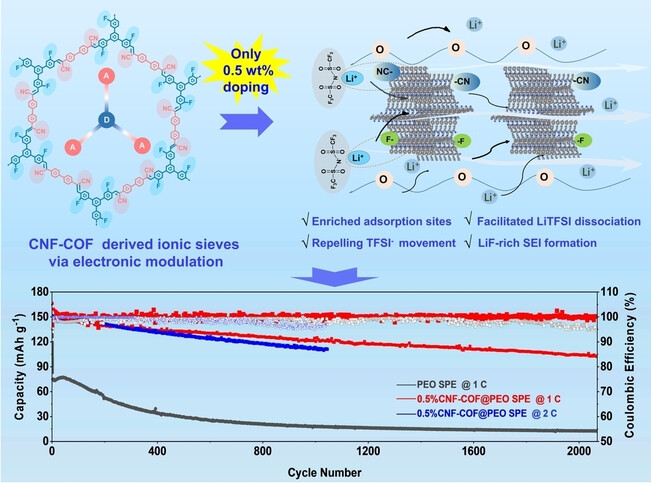
Cyano and fluorine dual-polar-group decorated multipolar polymer framework namely CNF-COF has been explored as an efficient and stable ionic sieve via electronic modulation to composite with solid polymer electrolytes for long-life all-solid-state (ASS) Li batteries at high rate. The CNF-COF incorporation not only affords rapid selective Li ion conduction, but also enables the LiF-rich SEI formation for stable Li anodes. Thus, the newly-developed composite electrolytes with an ultralow CNF-COF content of 0.5 wt % endow an ASS Li metal battery with excellent cycling stability over 2000 cycles at 1 C and over 1000 cycles at 2 C.
Biosynthesis
Elucidation of Palmarumycin Spirobisnaphthalene Biosynthesis Reveals a Set of Previously Unrecognized Oxidases and Reductases
- First Published: 06 April 2024

Palmarumycins are a major type of fungal spirobisnaphthalenes that are biosynthesized by two distantly located biosynthetic gene clusters (BGCs) jointly. PalA, an unusual, multifunctional P450, catalyzes the dimerization of DHNs to form the unique spiroketal and 2,3-epoxy groups. PalB installs the 5-hydoxy group, while PalC functions as a 1-reductase/dehydrogenase and epoxide reductase. PalD catalyzes the 1-dehydrogenation to form 1-keto products.
COFs
Covalent Organic Framework Interlayer Spacings as Perfectly Selective Artificial Proton Channels
- First Published: 06 April 2024
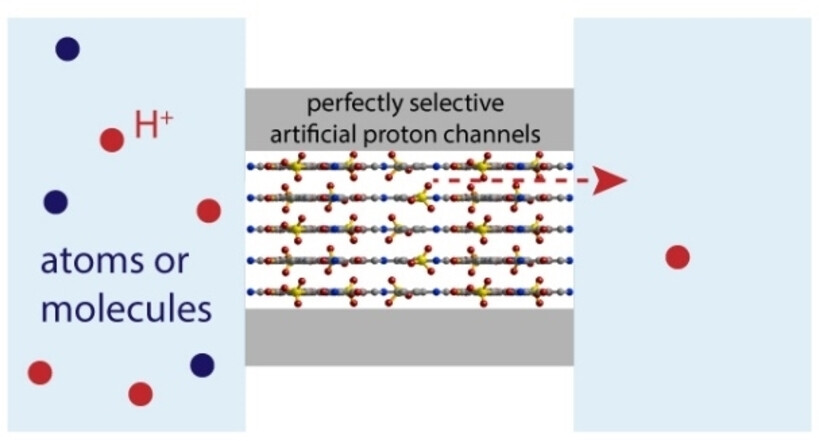
Bioinspired artificial proton channels that can sieving protons out of ions or water molecules with perfectly selectivity are constructed. The channels use the interlayer spacings of covalent organic framework materials consisting of hydrophilic functional groups to sterically reject all atoms or molecules, while providing hydrogen bonding network for proton hopping.
Supramolecular Chemistry | Very Important Paper
Expanding the Hydrophobic Cavity Surface of Azocalix[4]arene to Enable Biotin/Avidin Affinity with Controlled Release
- First Published: 02 April 2024
![Expanding the Hydrophobic Cavity Surface of Azocalix[4]arene to Enable Biotin/Avidin Affinity with Controlled Release](/cms/asset/867899f0-59ff-405f-a256-88f958e6a9f1/ange202402139-toc-0001-m.jpg)
A hypoxia-responsive azocalix[4]arene (Naph-SAC4A) has been developed that can achieve a biotin/(strept−)avidin-level binding affinity (up to 1013 M−1 ) through its expanded hydrophobic surface. Naph-SAC4A demonstrated the sensitive recognition of rocuronium in serum and a hypoxia-responsive delivery of doxorubicin with minimum leakage at the cellular level.
Urea Synthesis | Hot Paper
Tandem Catalysts Enabling Efficient C−N Coupling toward the Electrosynthesis of Urea
- First Published: 05 April 2024
Water Splitting
Strong Interactions between Au Nanoparticles and BiVO4 Photoanode Boosts Hole Extraction for Photoelectrochemical Water Splitting
- First Published: 02 April 2024
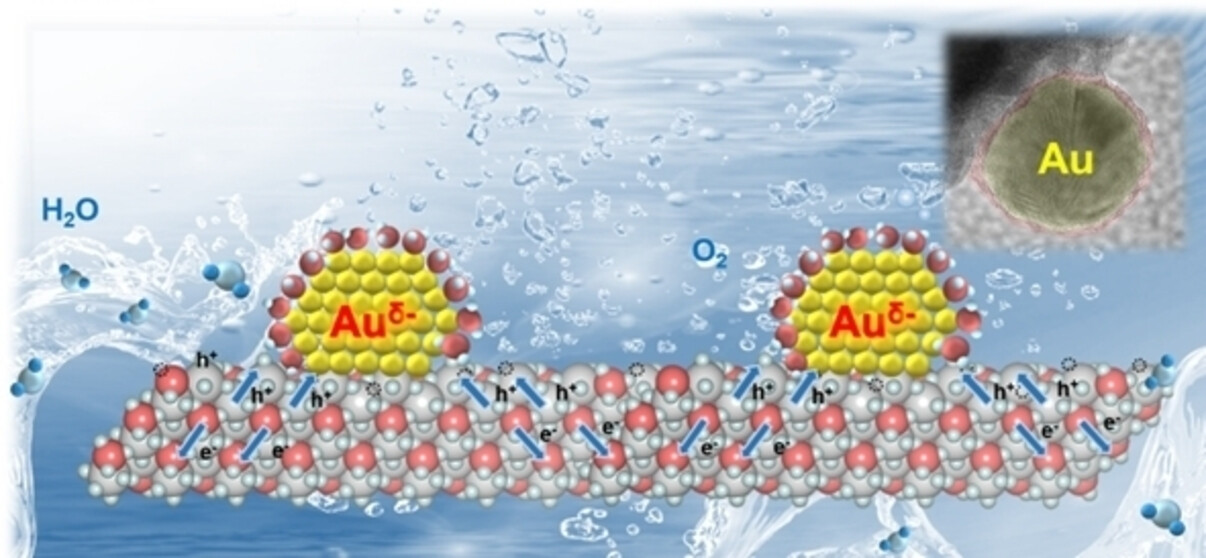
Strong metal-support interactions between Au nanoparticles and BiVO4 supports are achieved under reductive treatment for photoelectrochemical water splitting. The electron-rich Auδ− could extract photogenerated holes and accelerate the charge separation. The encapsulation of VOx on Au surface enhances the *OH adsorption and the *OOH generation to promote the oxygen evolution reaction kinetics.
Covalent Organic Frameworks | Hot Paper
Redox Molecular Junction Metal-Covalent Organic Frameworks for Light-assisted CO2 Energy Storage
- First Published: 28 March 2024
Biomolecular Chemistry | Hot Paper
Structure and Internal Dynamics of Short RNA Duplexes Determined by a Combination of Pulsed EPR Methods and MD Simulations
- First Published: 26 March 2024
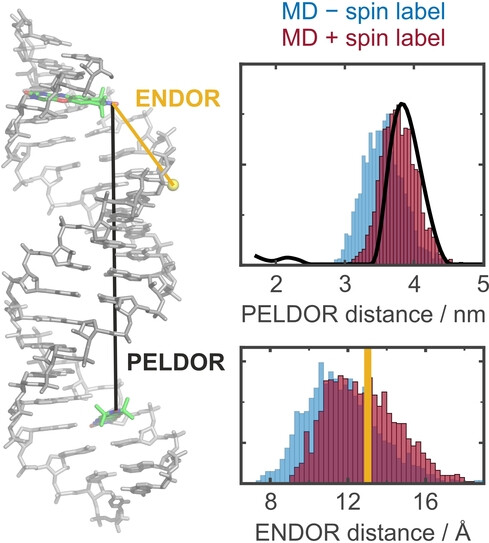
We combined orientation-selective PELDOR and 19F Mims ENDOR to characterize the structural ensemble of RNA duplexes and their internal motions. In a quantitative comparison to MD simulations of RNA with and without spin labels, we found that state-of-the-art force fields with explicit parameterization of the spin label can describe the conformational ensemble present in our experiments.
Polymer Membranes
Scalable Preparation of Ultraselective and Highly Permeable Fully Aromatic Polyamide Nanofiltration Membranes for Antibiotic Desalination
- First Published: 08 April 2024
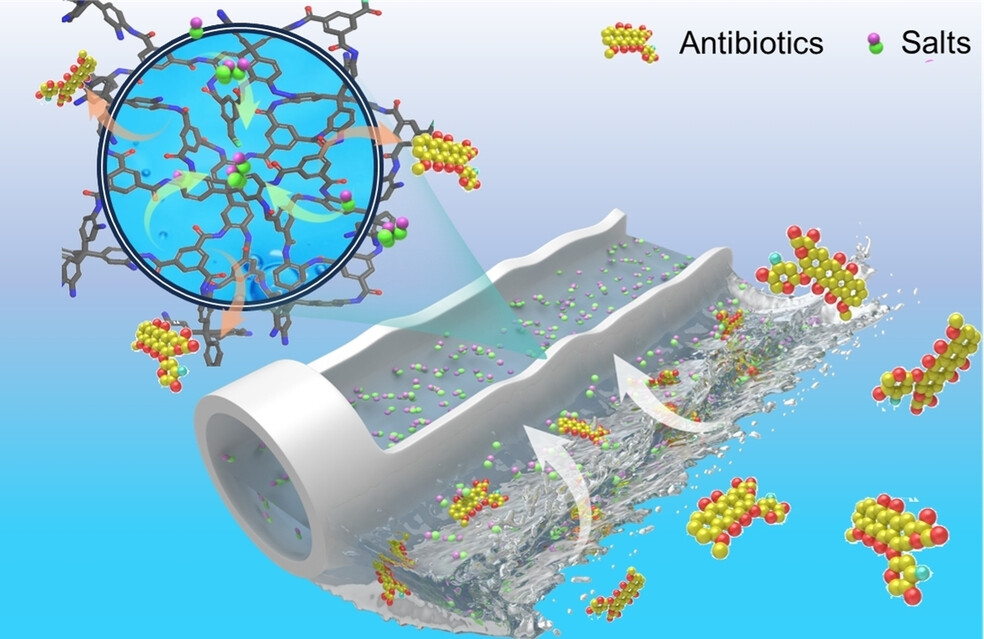
A noncoplanar polyaromatic amine, 4,4′,4′′,4′′′-methanetetrayltetrakis(benzene-1,2-diamine) (MTLB), was used as a molecular building block for fabricating thin-film composite membranes via interfacial polymerization. The resulting membrane exhibited a high salt/antibiotic selectivity and water permeance. The excellent antibiotic desalination performance can be maintained in industrial-scale spiral-wound module.
Polycycles
Synthesis, Structures and Properties of Trioxa[9]circulene and Diepoxycyclononatrinaphthalene
- First Published: 02 April 2024
![Synthesis, Structures and Properties of Trioxa[9]circulene and Diepoxycyclononatrinaphthalene](/cms/asset/871f42d9-02df-4b78-b04a-a0dd4f14508d/ange202402756-toc-0001-m.jpg)
Trioxa[9]circulene and dimethoxydiepoxycyclononatrinaphthalene were synthesized through intramolecular oxidative coupling of dimethoxydioxa[8]helicene, resulting in the formation of a nine-membered ring. Dimethoxydioxa[8]helicene and dimethoxydiepoxycyclononatrinaphthalene exhibit absorption and luminescence dissymmetry factors on the order of 10−2, and trioxa[9]circulene exhibits remarkable π–π interactions in the crystals.
Polycyclic Aromatic Hydrocarbons
Helicene Aromaticity Deviates from the Clar Rule—On the Electronic Dissimilarity of Large Isomeric Fibonacenes
- First Published: 03 April 2024

Long isomeric fibonacenes—a phenacene, a helicene and a croissant-shaped isomer—are found to show strikingly different absorption and emission spectra, despite their equivalent Kekulé structures. Complementary computations based either on magnetic or electronic criteria for aromaticity indicate that in long helicenes, the Clar and Kekulé rules of preferred sextet localization do not hold.
Zeolites | Hot Paper
Exploring the Impact of Active Site Structure on the Conversion of Methane to Methanol in Cu-Exchanged Zeolites
- First Published: 04 April 2024
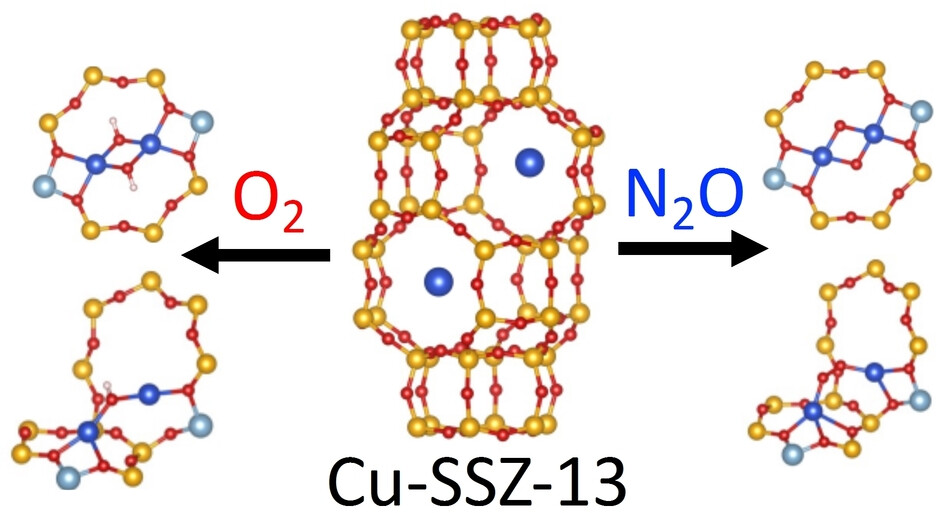
We modify activation conditions to stabilize different Cu-oxo and Cu-hydroxyl dimers in the zeolite SSZ-13. Subsequently we combine theory and experiment to investigate how the Cu site structure impacts the conversion of methane to methanol. Our results indicate that site stoichiometry controls methanol production in a stepwise conversion process.
Hybrid Catalysts
Implanting Colloidal Nanoparticles into Single-Crystalline Zeolites for Catalytic Dehydration
- First Published: 05 April 2024
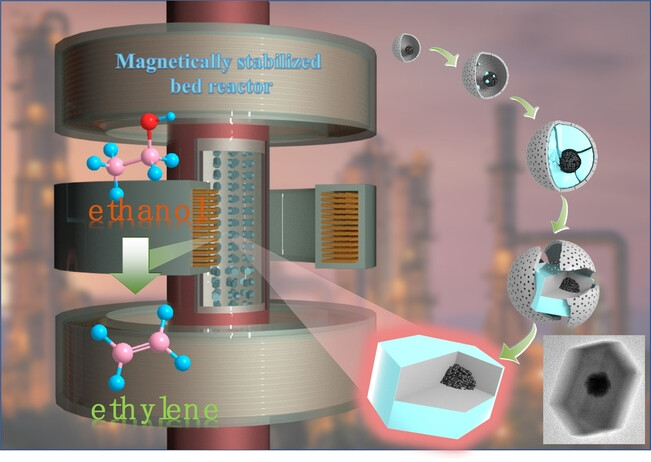
A magnetic zeolite with Fe3O4 colloidal nanoparticles nucleus and single-crystalline ZSM-5 zeolites shell have been fabricated by a stepwise crystallization strategy. The resulting Fe3O4@HZSM-5 catalyst shows a high catalytic activity, selectivity, and stability for the dehydration of ethonal in a magnetically stabilized bed (MSB) reactor.
Potassium-Ion Batteries | Hot Paper
Chloro-Functionalized Ether-Based Electrolyte for High-Voltage and Stable Potassium-Ion Batteries
- First Published: 10 April 2024
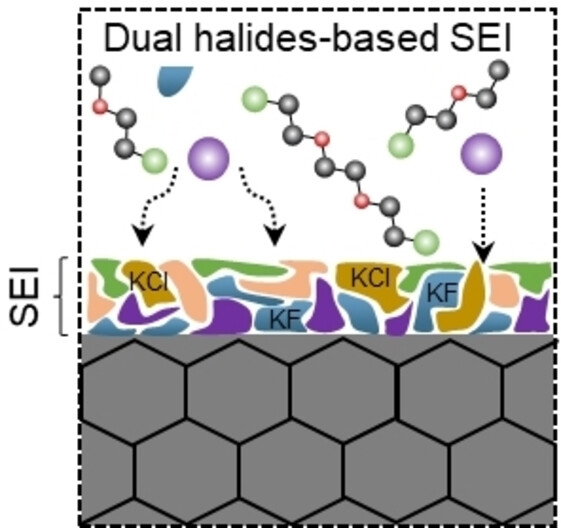
The ether-based electrolyte functionalized with an electron-withdrawing group (chloro-substitution) enabled the formation of a dual halides-based solid-electrolyte interphase (SEI), thereby enhancing the cycling stability (6000 cycles), high voltage (4.3 V) performance, and wide temperature operation (−5 °C to 45 °C) of potassium ion batteries.
Charge Transfer | Hot Paper
Light Induced Proton Coupled Charge Transfer Triggers Counterion Directional Translocation
- First Published: 05 April 2024
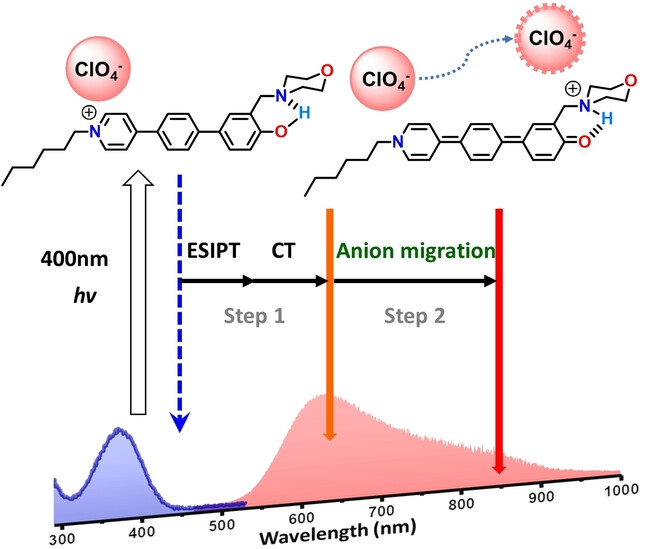
The light-triggered translocation of ClO4− anion from cationic to neutral-binding site along BPym-OH dye is visualized by emission. The combination of time-resolved fluorescence and molecular dynamic simulation allows its description in time and energy domains. This reaction generates dramatically red-shifted fluorescence extending to near-IR that appears at ~83 ps, resulting from electrochromic modulation of coupled proton-electron transfer.
Gas Separation | Very Important Paper
One-Step Butadiene Purification in a Sulfonate-Functionalized Metal–Organic Framework through Synergistic Separation Mechanism
- First Published: 05 April 2024
Nanoclusters
Temperature-Controlled Selective Formation of Silver Nanoclusters and Their Transformation to the Same Product
- First Published: 05 April 2024
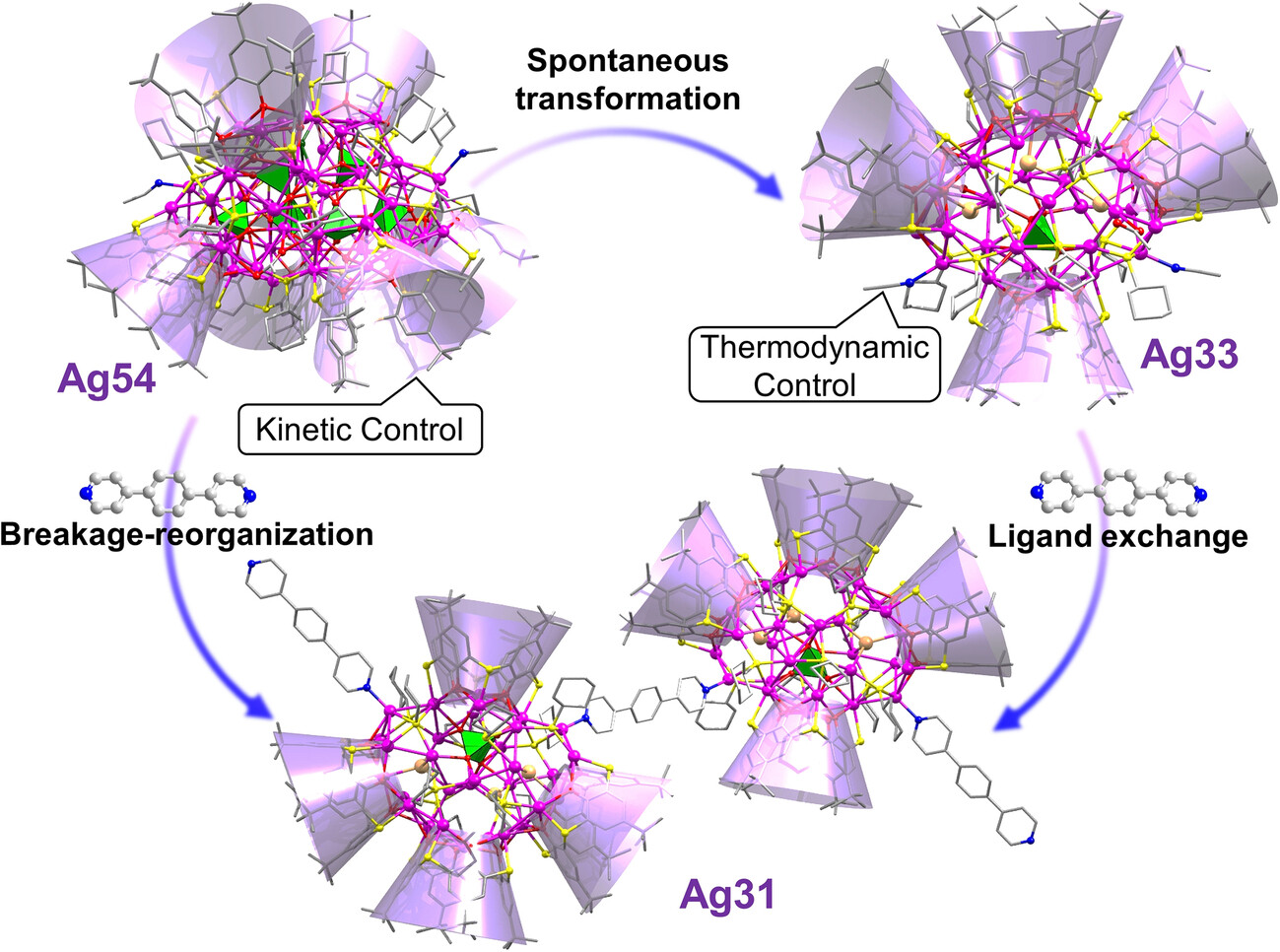
Two different p-tert-butylthiacalix[4]arene protected silver nanoclusters (Ag54 and Ag33) with different stabilities were isolated from identical reactants under different temperatures. Upon stimulation with bpbenz (bpbenz=1,4-bis(pyrid-4-yl)benzene), the kinetically metastable Ag54 and the thermodynamically stable Ag33 can yield the same product of Ag31via the breakage-reorganization and ligand exchange transformation mechanism, respectively.
Sodium-Ion Batteries | Very Important Paper
Monolithic Interphase Enables Fast Kinetics for High-Performance Sodium-Ion Batteries at Subzero Temperature
- First Published: 02 April 2024

This work constructs a monolithic and amorphous electrode/electrolyte interphase at low temperature which is thin, stable, and contains more organic components, facilitating fast Na+ kinetics, enabling sodium-ion batteries to achieve long-term cycling performance and great rate capability at −30 °C.
Luminescent Material
Tunable Narrow-Band Cyan-Emission of Eu2+-doped Nitridomagnesophosphates Ba3−xSrx[Mg2P10N20] : Eu2+ (x=0–3)
- First Published: 03 April 2024
![Tunable Narrow-Band Cyan-Emission of Eu2+-doped Nitridomagnesophosphates Ba3−xSrx[Mg2P10N20] : Eu2+ (x=0–3)](/cms/asset/c2a64e53-649a-4ad4-8917-6ed611e219ad/ange202403648-toc-0001-m.jpg)
We present the first solid solution series of the new class of nitridomagnesophosphates with excellent luminescence properties in the cyan spectral range, tunable by Ba/Sr ratio. Extensive investigations have made it possible to attribute the luminescence to the doping of one crystallographic site. DFT calculations were carried out to investigate the influence of Mg in the P/N network for the first time.
Inorganic Materials | Hot Paper
Control of Polarity in Kagome-NiAs Bismuthides
- First Published: 12 March 2024
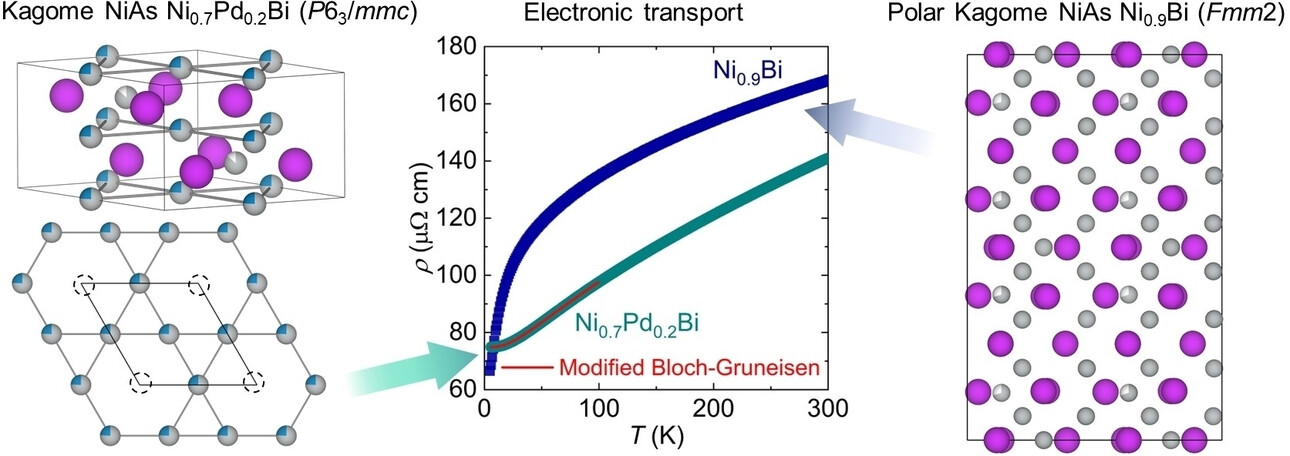
Ordered octahedral site vacancies and filling of trigonal bipyramidal interstitial sites by transition metals stabilizes a 2×2×1 P63/mmc superstructure of NiAs with kagome nets in Ni0.7Pd0.2Bi, Ni0.6Pt0.4Bi, and Mn0.99Pd0.01Bi. Further ordering of the interstitial sites via composition generates a net polarization in Ni0.9Bi and Ni0.79Pd0.08Bi with polar Fmm2 symmetry. The control of polarity is reflected in electronic transport properties.
Coordination Cages
Cage-To-Cage Transformations in Self-Assembled Coordination Cages Using “Acid/Base” or “Guest Binding-Induced Strain” as Stimuli
- First Published: 03 April 2024
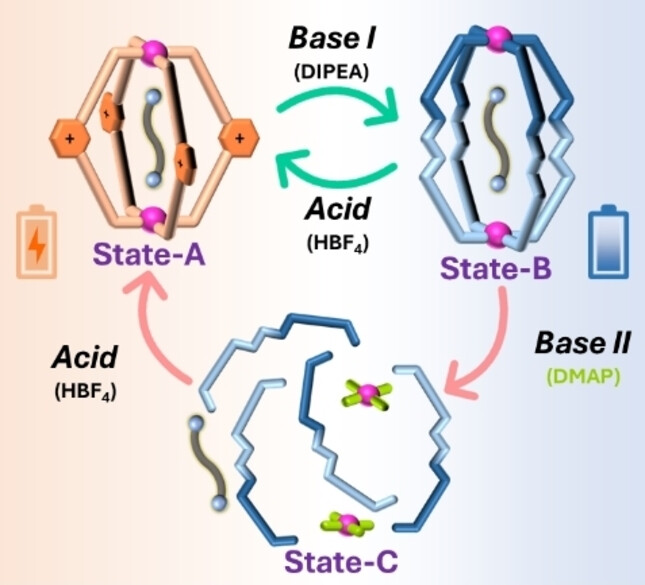
A pair of acid/base responsive cages that can be interconverted without affecting the coordination environment have been self-assembled from 1,5-enedione/pyrylium based ligands, leading to a three-state supramolecular switch that can be controlled through strong acid/bases. A guest-binding-induced strain-triggered cage-to-cage transformation was found, in addition to chemical stimuli (acid/base, NH3) responsive cage transformations.
Polymer Chemistry | Hot Paper
Nanogels with Metal-Organic Cages as Functional Crosslinks
- First Published: 05 April 2024
Electrocatalysis | Hot Paper
An Electrocatalytic Cascade Reaction for the Synthesis of Ketones Using CO2 as a CO Surrogate
- First Published: 22 April 2024

This work reports an electrocatalytic cascade method for synthesizing ketones using CO2 as a CO surrogate. By employing a synergistic combination of two earth-abundant metal catalysts, high yields are achieved in a simple setup, demonstrating the potential for sustainable and efficient carbonylation reactions.
Aqueous Zn-Ion Batteries
Zigzag Hopping Site Embedded Covalent Organic Frameworks Coating for Zn Anode
- First Published: 22 March 2024
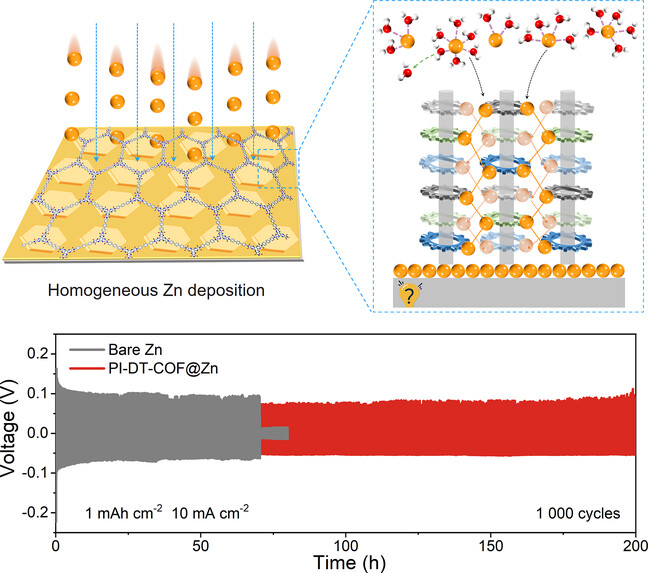
A series of anhydride-based covalent organic frameworks (i.e., PI-DP-COF and PI-DT-COF) with specifically designed zigzag hopping sites and zincophilic anhydride groups that can serve as desired platforms to investigate the related Zn2+ hopping/transfer, dendrite-inhibition, and plating/stripping behaviours as well as the interfacial interaction.
Reaction Mechanisms
Accumulation, Characterization and Reactivity of Chiral Ammonium-Carboxonium Dications in Superacid
- First Published: 08 April 2024
Polymer Chemistry | Hot Paper
Aqueous Coordination-Insertion Copolymerization for Producing High Molecular Weight Polar Polyolefins
- First Published: 28 March 2024
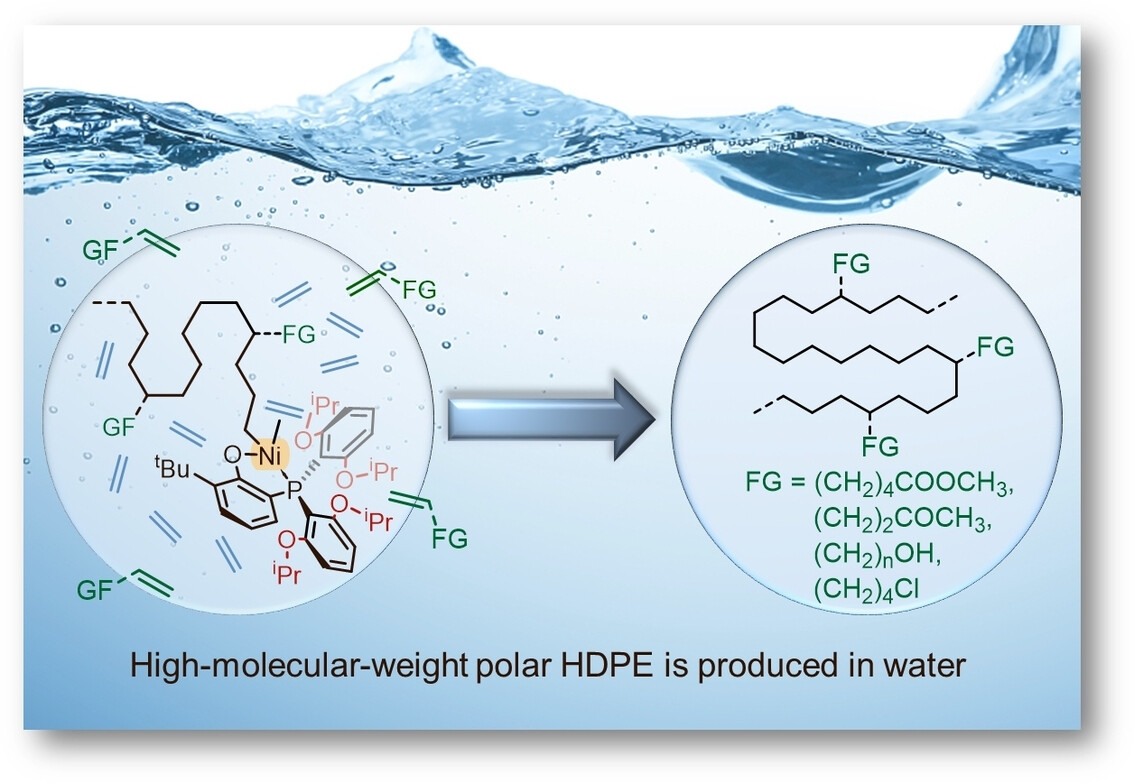
Water, a poison in traditional olefin polymerization processes using Ziegler–Natta catalysts, enables coordination-insertion copolymerization of ethylene and diverse polar monomers to produce significantly high-molecular-weight linear polar polyolefins (219–549 kDa) using single-component and neutral nickel catalysts under mild conditions.
Cancer Therapy
A Light-Triggered J-Aggregation-Regulated Therapy Conversion: from Photodynamic/Photothermal Therapy to Long-Lasting Chemodynamic Therapy for Effective Tumor Ablation
- First Published: 05 April 2024
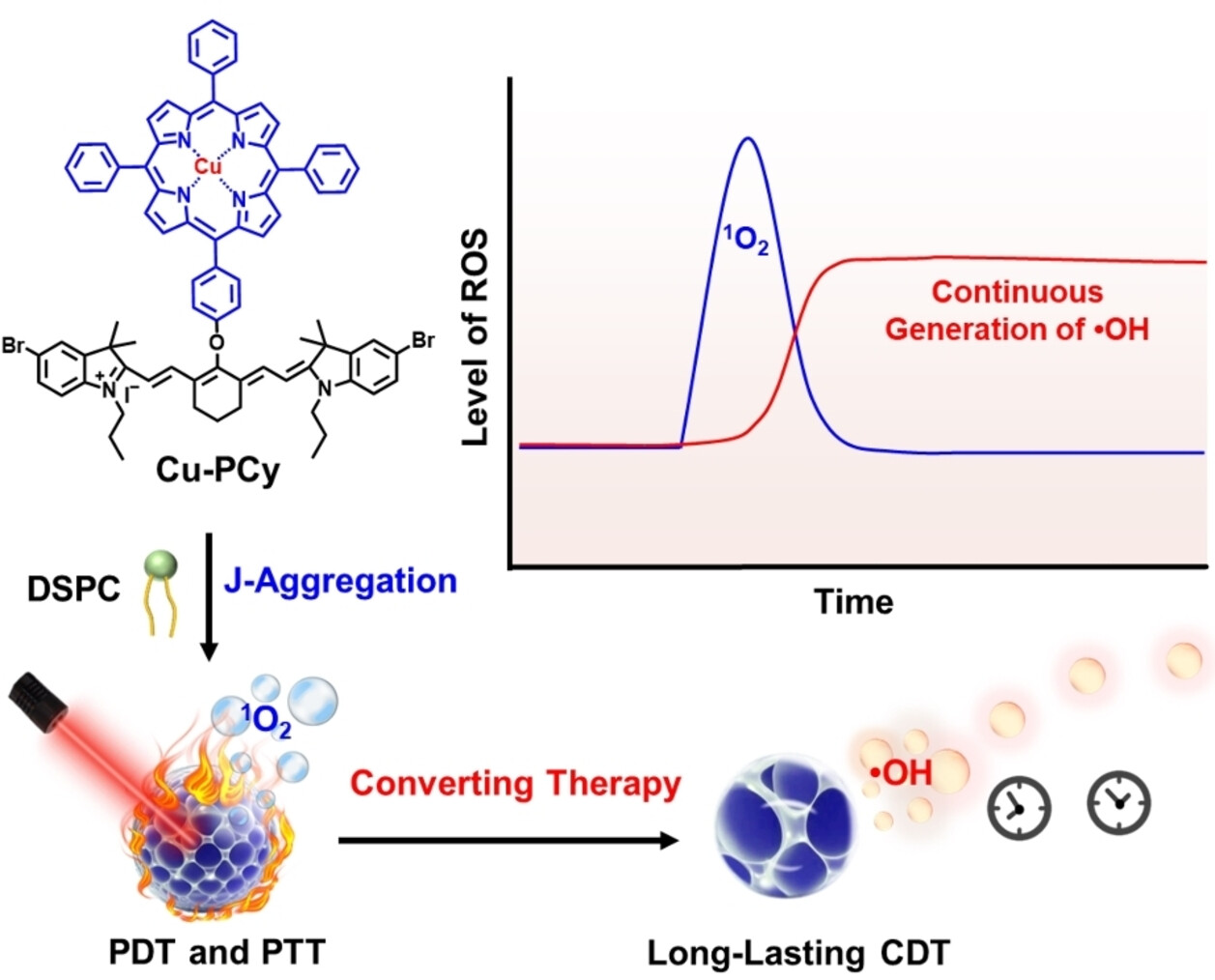
A light-triggered J-aggregates system is developed for a converting cancer therapy with enhanced therapeutic outcomes. The photodegradation of cyanine leads to the destruction of J-aggregation, facilitating the conversion from photodynamic/photothermal therapy to long-lasting chemodynamic therapy. This work presents a safe and effective strategy for prolonging the therapeutic efficacy of ROS-based therapy.
Li-Metal Batteries | Hot Paper
In-Situ Cross-linked F- and P-Containing Solid Polymer Electrolyte for Long-Cycling and High-Safety Lithium Metal Batteries with Various Cathode Materials
- First Published: 22 March 2024
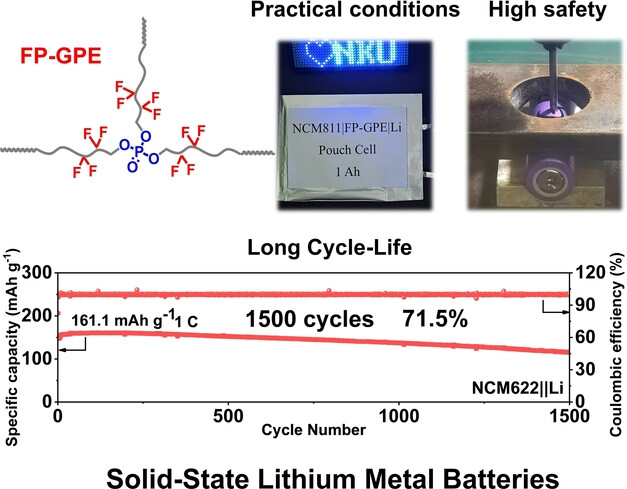
A fluorinated phosphate cross-linked gel polymer electrolyte (FP-GPE) has been designed and fabricated for high-voltage lithium metal batteries (LMBs). The FP-GPE-based batteries display excellent electrochemical performance and high safety simultaneously even at practical conditions. Moreover, the first reported solid-state 18650 cylindrical LMBs have been successfully fabricated and demonstrate exceptional safety under mechanical abuse.
Heterogeneous Catalysis
Solar-Light-Driven Photocatalytic Oxidative Coupling of Phenol Derivatives over Bismuth-Based Porous Metal Halide Perovskites
- First Published: 19 March 2024
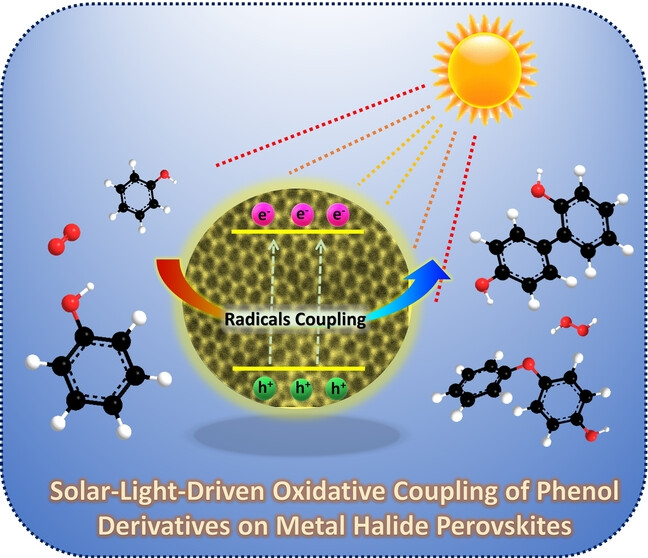
A series of porous bismuth-based metal halide perovskites with tunable band gap compositions are prepared and explored as photocatalysts for solar-light-driven oxidative phenol C−C and C−O coupling reactions. The porous morphology, appropriate band-edge alignment and Lewis acid sites of CsBi2Br9 are found to play a crucial role in stabilizing the phenolic intermediates, thereby boosting the reaction kinetics.
Low-Valent Compounds
Mercury-Group 13 Metal Covalent Bonds: A Systematic Comparison of Aluminyl, Gallyl and Indyl Metallo-ligands
- First Published: 28 March 2024

Aided by the syntheses of potassium indyl reagents, access is possible for the first time to a complete series of metal-trielyl complexes featuring the same xanthene-derived NON-framework. Analysis of mercury compounds of the type (boryl)HgE(NON) (E=Al, Ga, In) by structural, spectroscopic and theoretical methods shows that the aluminyl metallo-ligand [(NON)Al]− is the most potent σ-donor.
Covalent Organic Frameworks | Hot Paper
Pyridine-Based Covalent Organic Frameworks with Pyridyl-Imine Structures for Boosting Photocatalytic H2O2 Production via One-Step 2e− Oxygen Reduction
- First Published: 02 April 2024

The work reports a pyridine-based covalent organic frameworks (COFs) functionalized with pyridyl-imine structures to boost photocatalytic hydrogen peroxide (H2O2) production. The unique pyridyl-imine structures can effectively suppress the two-step two-electron (2e−) oxygen reduction reaction (ORR) process on imine-nitrogen sites, facilitating a more efficient one-step 2e− pathway for H2O2 production.
Heterogeneous Catalysis | Hot Paper
In Situ Observation of Solvent-Mediated Cyclic Intermediates during the Alkene Epoxidation/Hydration over a Ti-Beta/H2O2 System
- First Published: 20 March 2024
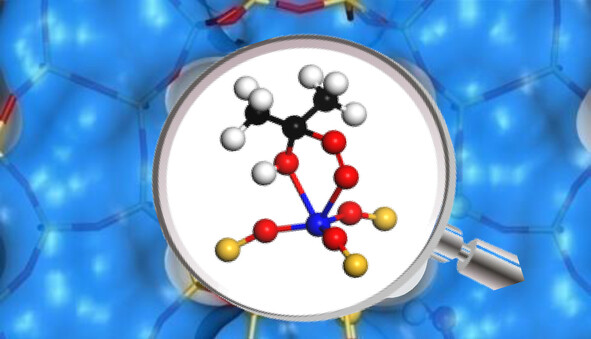
The aprotic acetone-mediated five-membered-ring intermediate as the active site for the epoxidation reaction over a Ti-Beta/H2O2 system is observed for the first time by using in situ and 2D MAS NMR spectroscopy and theoretical calculations. The critical role of this intermediate in cyclohexene epoxidation is revealed.
H2O2 Electrosynthesis
Validating ΔΔG Selectivity Descriptor for Electrosynthesis of H2O2 from Oxygen Reduction Reaction
- First Published: 21 March 2024
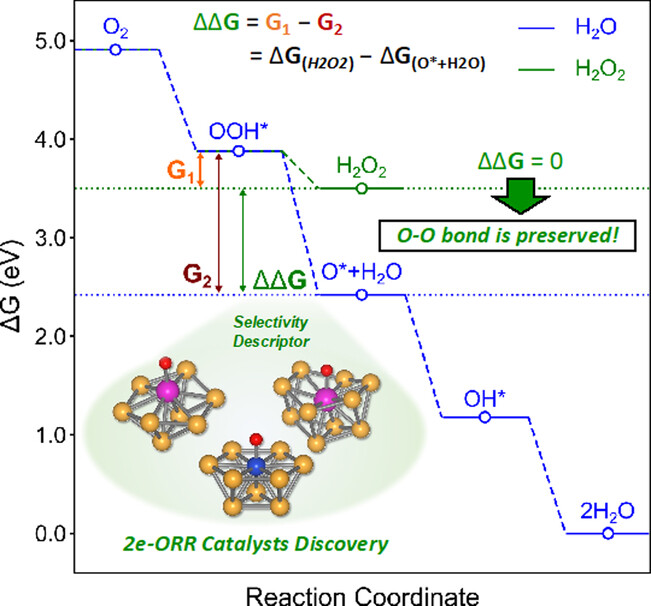
While descriptor-based analysis has effectively delineated activity trends, addressing selectivity trends has proven to be a challenging hurdle in the quest to develop innovative catalysts for electrosynthesis of hydrogen peroxide via 2e-ORR. This contribution validates the efficacy of a novel selectivity descriptor, ΔΔG, using an extensive library of binary alloys. We demonstrate ΔΔG as the ultimate selectivity descriptor for 2e-ORR.
CO2 Reduction
CO Intermediate-Assisted Dynamic Cu Sintering During Electrocatalytic CO2 Reduction on Cu−N−C Catalysts
- First Published: 08 April 2024
Oxygen Reduction | Hot Paper
Unveiling Low Temperature Assembly of Dense Fe-N4 Active Sites via Hydrogenation in Advanced Oxygen Reduction Catalysts
- First Published: 03 April 2024
Polymer Chemistry
Modification of Polysulfide Surfaces with Low-Power Lasers
- First Published: 19 March 2024
K-ion Storage
Unlocking Spin Gates of Transition Metal Oxides via Strain Stimuli to Augment Potassium Ion Storage
- First Published: 08 April 2024
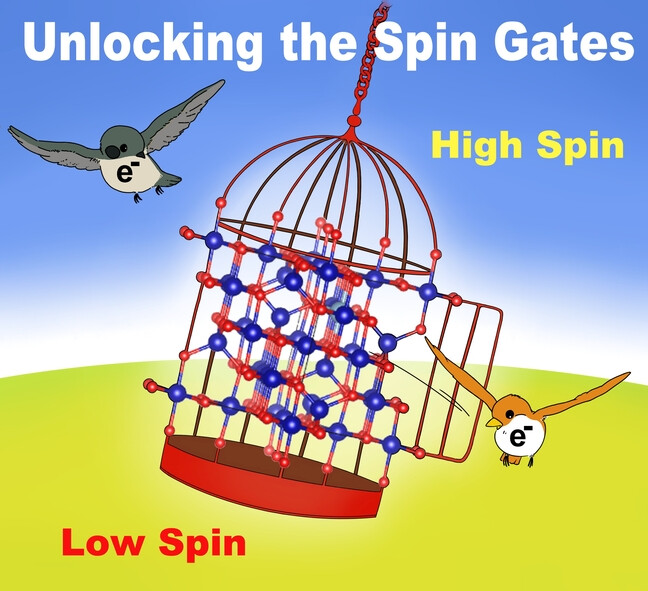
The unlocked birdcage symbolizes the material opening its spin gates, with the liberated bird representing charges. By unlocking the spin gates, the movement of charges becomes smooth and unrestricted, corresponding to the enhanced dynamics and stability of transition metal oxides during energy storage processes.
Molecular Switches | Hot Paper
Orthogonal Photoswitching in a Porous Organic Framework
- First Published: 26 March 2024
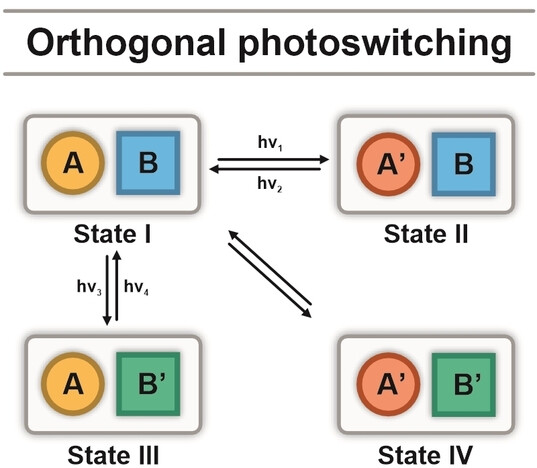
Two photoswitches, i.e., 6-nitro-spiropyran and o-fluoroazobenzene are shown to operate in a wavelength-orthogonal manner both in solution and when integrated into a porous material scaffold. Selective isomerization of each photoswitch can be triggered by a specific wavelength of light giving rise to four independently accessible states of the porous material, thus providing a basis for the dynamic multifunctional materials.
Heterogeneous Catalysis | Hot Paper
Single-Atom Titanium on Mesoporous Nitrogen, Oxygen-Doped Carbon for Efficient Photo-thermal Catalytic CO2 Cycloaddition by a Radical Mechanism
- First Published: 06 April 2024
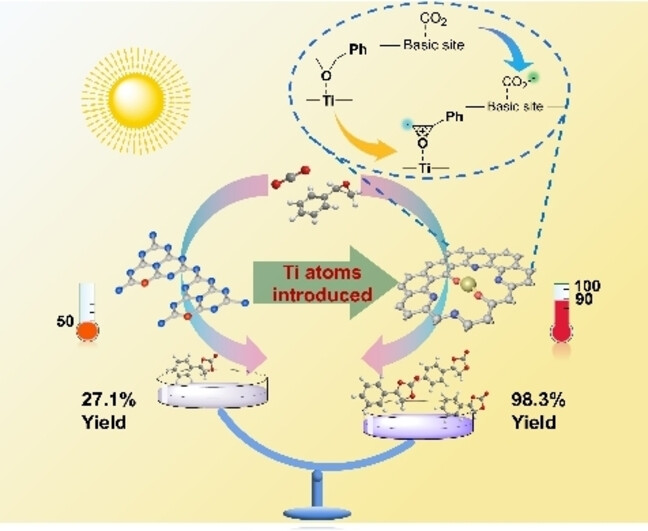
Atomically dispersed Ti−CNO catalysts are synthesized for photothermal catalytic cycloaddition of styrene oxide and CO2 to styrene carbonate, achieving an excellent catalytic performance (98.3 % in 6 h, 10 cycles). The addition of Ti single atoms creates abundant mesoporous structure, enhances photothermal effect and Lewis acidic/basic sites, which facilitate the activation of styrene oxide and CO2 to form styrene oxide.+ and CO2.−, respectively.
Heterogeneous Catalysis | Very Important Paper
The Importance of Sintering-Induced Grain Boundaries in Copper Catalysis to Improve Carbon-Carbon Coupling
- First Published: 02 April 2024
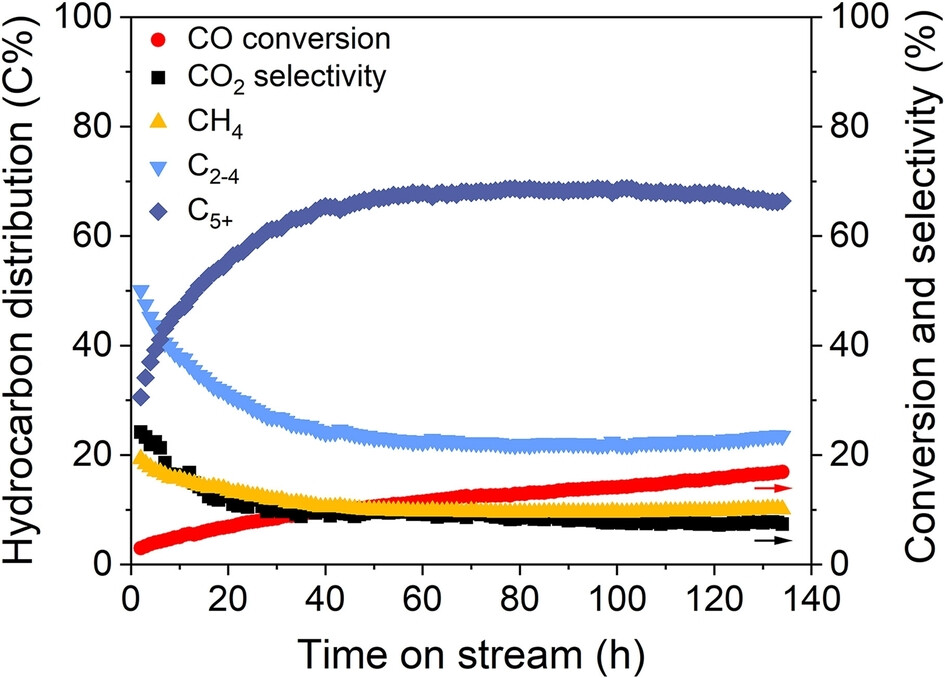
Syngas conversion reaction induces the in situ generation of copper grain boundaries which leads to the formation of long-chain hydrocarbons. The synergy of grain boundaries and their vicinal low-index facets leads to the CO insertion where non-dissociative adsorbed CO on low-index facets migrates to grain boundaries and inserts into the metal-alkyl bond for the chain growth.
Organometallic Systems | Hot Paper
Metalla-Carbaporphyrinoids Consisting of an Acyclic N-Confused Tetrapyrrole Analogue Served as Stable Near-Infrared-II Dyes
- First Published: 02 April 2024
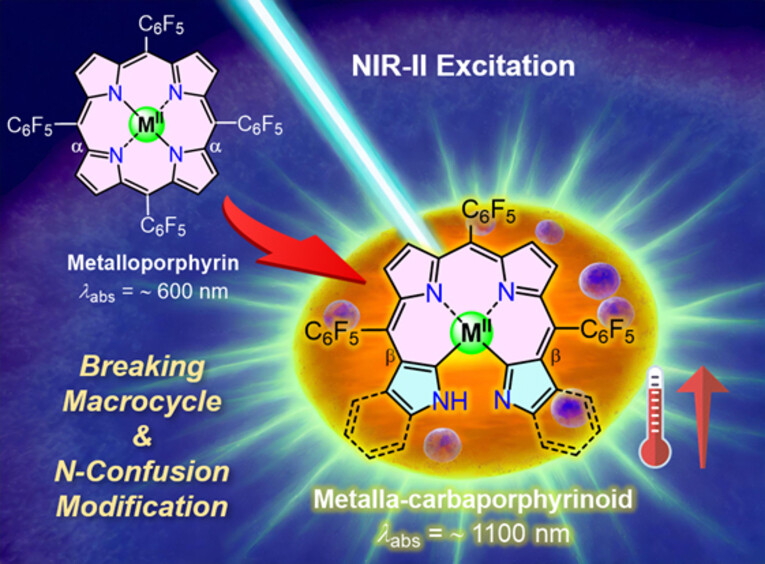
Breaking the tetrapyrrolic π-skeleton and implementing N-confusion modification offer a distinctive ligand platform for metalla-carbaporphyrinoid species. Through d-π orbital interaction, the resultant open-ring Pd/Pt complexes demonstrate near-infrared-II absorption capability and high photothermal conversion efficiency.
Drug Metabolism
CYP3A Mediates an Unusual C(sp2)−C(sp3) Bond Cleavage via Ipso-Addition of Oxygen in Drug Metabolism
- First Published: 04 April 2024
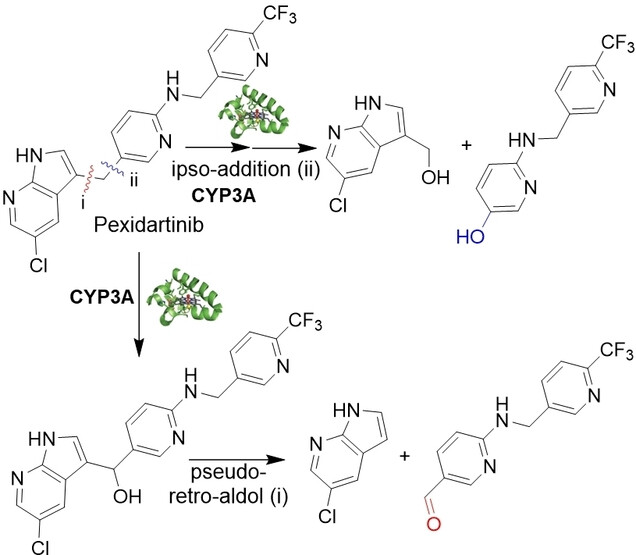
Mammalian cytochrome P450 drug metabolizing enzymes rarely cleave C−C bonds. Here we report the mechanisms of two unusual CYP3A-mediated cleavages of non-polar, unstrained C(sp2)−C(sp3) bonds in the metabolism of tyrosine kinase inhibitor pexidartinib. One bond is cleaved by CYP3A-mediated ipso-addition of activated oxygen, and the other occurs by a pseudo-retro-aldol reaction after hydroxylation of a C(sp3) site.
Supramolecular Chemistry
Efficient and Selective Construction of 412 Metalla-links Using Weak C−H⋅⋅⋅Halogen Interactions
- First Published: 03 April 2024
Frustrated Lewis Pairs
Finding Natural, Dense, and Stable Frustrated Lewis Pairs on Wurtzite Crystal Surfaces for Small-Molecule Activation
- First Published: 05 April 2024
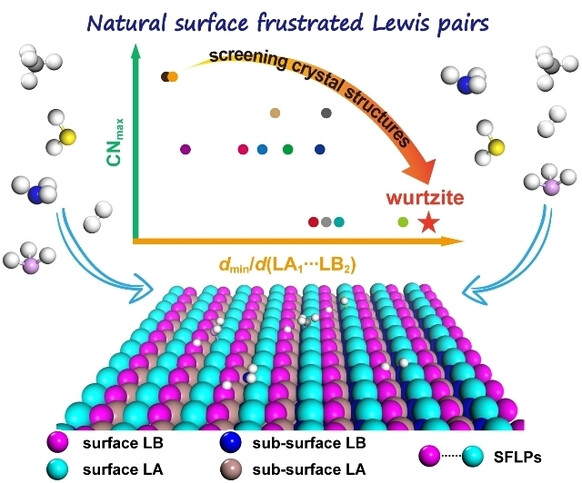
Natural surface frustrated Lewis pairs (SFLPs) are found on the stable wurtzite crystal surfaces. All the surface atoms serving as Lewis acid/base sites contribute to the surface density of SFLPs reaching up to the highest value to date. The approaching orbital orientations of SFLPs are the origin of the outstanding performance for the activation of small molecules, thereby demonstrating great potential in heterogeneous catalysis.
Batteries
Anion–Cation Competition Chemistry for Comprehensive High-Performance Prussian Blue Analogs Cathodes
- First Published: 02 April 2024
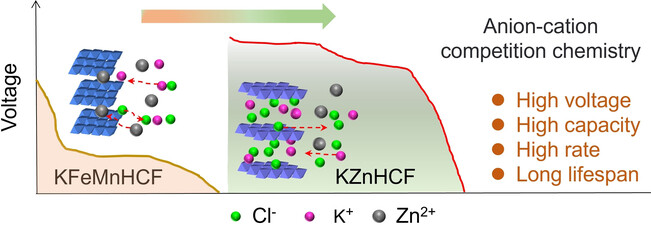
After high-voltage CV scanning, the higher (de)intercalation voltage and lower diffusion activation energy for both Cl− and K+ boost the comprehensive improvement of the discharge voltage, capacity, rate and cyclic performance. The comprehensive improvement of electrochemical performance utilizing anion-cation competition chemistry is universal for different types of PBAs.
Spin Crossover
High-performance Pyroelectric Property Accompanied by Spin Crossover in a Single Crystal of Fe(II) Complex
- First Published: 08 April 2024

A spin-crossover Fe(II) complex demonstrating high-performance pyroelectricity across a remarkably wide temperature range just above room temperature was reported. Detailed structural analyses revealed that pyroelectric response can be ascribed to a giant thermal expansion of polar axis accompanied by a gradual low-spin to high-spin transition of metal centers.
Vitrimers
Adaptive and Robust Vitrimers Fabricated by Synergy of Traditional and Supramolecular Polymers
- First Published: 08 April 2024

We couple boron-nitrogen (B−N) dative bonds and B−O covalent bonds to generate a new class of vitrimers, boron-nitrogen vitrimers (BNVs), to endow them with dynamic features at usage temperatures. Compared with boron-ester vitrimers (BEVs) without B−N dative bonds, the BNVs showcase enhanced mechanical performance.
Goldkatalyse
Gold(I)-katalysierte Intramolekulare 7-endo-dig Zyklisierung von Trien-In-Systemen: Neuer Zugang zu Azulenothiophenen
- First Published: 26 March 2024
Biosynthese
Strukturelle Einblicke in die Terpencyclasedomänen Zweier Pilzlicher Sesterterpensyntasen und Enzymengineering zur Diversifizierung von Sesterterpenen
- First Published: 07 April 2024
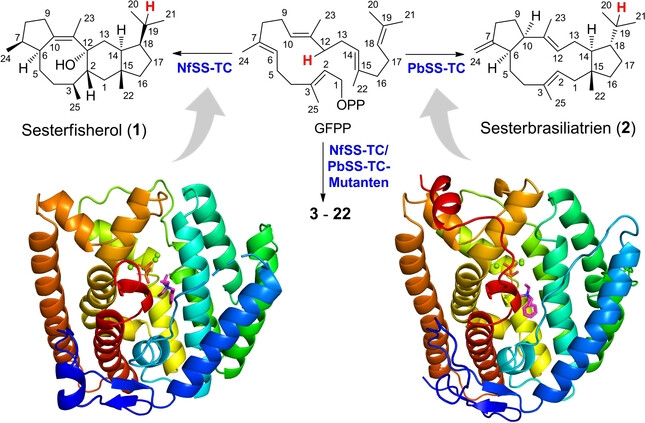
Die Kristallstrukturen der Terpencyclasedomänen (TC) zweier pilzlicher Sesterterpensynthasen (NfSS und PbSS) wurden bestimmt. Die Modellierung carbokationischer Intermediate, ortsgerichtete Mutagenese und Isotopenmarkierung lieferte detaillierte Einblicke in ihre katalytischen Mechanismen. Strukturbasiertes Engineering von NfSS und PbSS führte zur Bildung von 20 Sesterterpenen, darunter 13 neue Verbindungen.
Zuschriften
Photocatalysis
Asymmetric Synthesis
Diversified Synthesis of Chiral Fluorinated Cyclobutane Derivatives Enabled by Regio- and Enantioselective Hydroboration
- First Published: 02 April 2024

The first asymmetric hydroboration of cyclobutenes using Rh catalysis is reported, providing gem-difluorinated α-boryl cyclobutanes in excellent regio- and enantioselectivity. Upon in situ B,F-elimination (Pd is required for R=aryl), monofluorinated cyclobutenes are obtained through formal hydrodefluorination. Versatile downstream transformations make this method a platform for the diversified synthesis of chiral fluorinated cyclobutanes.
Homogeneous Catalysis
Catalytic Access to Diastereometrically Pure Four- and Five-Membered Silyl-Heterocycles Using Transborylation
- First Published: 05 April 2024
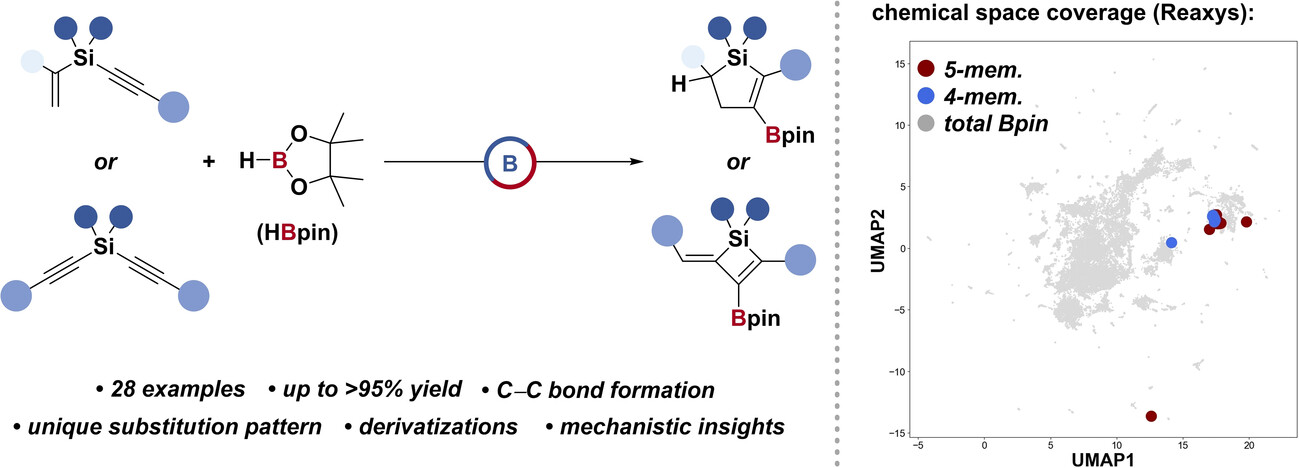
Silyl-heterocycles offer a unique handle to expand and explore chemical space, reactivity, and functionality. These are limited by the lack of catalytic methods for the preparation of diverse and functionalized silyl-heterocycles. Herein the borane-catalyzed intramolecular 1,1-carboboration of silyl-alkynes has been developed for the synthesis of 2,3-dihydrosilolyl and silylcyclobut-2-enyl boronic esters.
Asymmetric Catalysis
Enantioselective Tsuji-Trost α-Fluoroallylation of Amino Acid Esters with Gem-Difluorinated Cyclopropanes
- First Published: 27 February 2024

A robust palladium/nickel/chiral aldehyde synergistic relay system was developed for the enantioselective ring-opening functionalization of gem-difluorinated cyclopropanes with N-unprotected amino acid esters, enabling the efficient assembly of α-quaternary α-amino acid esters bearing a linear 2-fluoroallylic motif in a highly enantioselective manner.
Regiodivergent Catalysis
Hydrogen Source Tuned Regiodivergent Asymmetric Hydroalkylations of 2-Substituted 1,3-Dienes with Aldehydes by Cobalt-Catalysis
- First Published: 03 April 2024

Catalytic methods to access different regio- and enantiomers by switching the least reaction parameters are attractive yet challenging. Herein, a Co-catalyzed regiodivergent and enantioselective reductive hydroalkylation of 1,3-dienes with aldehydes have been achieved, allowing for regio-switchable 1,2-hydroalkylation and 4,3-hydroalkylation of 1,3-dienes to furnish different homoallylic alcohol architectures from identical starting materials.
Liquid Crystals | Hot Paper
Supertwisted Chiral Gyroid Mesophase in Chiral Rod-Like Compounds
- First Published: 02 April 2024
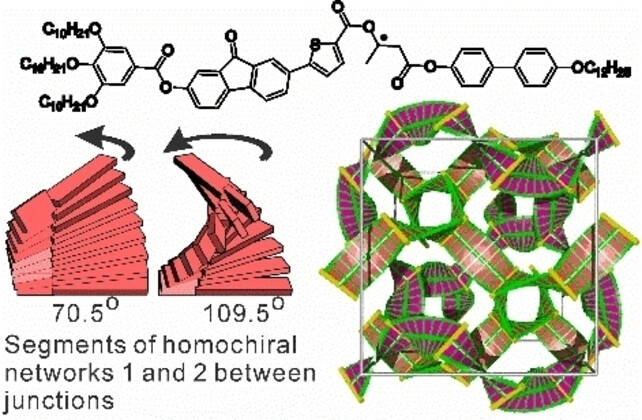
Molecules that cannot self-assemble in either layers or cylinders often form complex in-between “bicontinuous” structures made up of interpenetrating networks. The most widespread is the achiral “gyroid” phase, containing two antichiral networks. Here it is shown that the introduction of an asymmetric unit into the rod-like molecular core can rewind the segments of one of the nets, “supertwisting” them in reverse and making the famous gyroid chiral.
Polymer Chemistry | Very Important Paper
High-Performance Thermoelectric Fibers from Metal-Backboned Polymers for Body-Temperature Wearable Power Devices
- First Published: 04 April 2024

A novel nickel-backboned polymer/carbon nanotube thermoelectric composite fiber is fabricated through a shear-induced orientation method. It shows simultaneous increases in electrical conductivity and Seebeck coefficient, with a power factor of 719.48 μW m−1 K−2 as high as 3.5 times of the bare carbon nanotube fiber, opening a new avenue for the development of metal-backboned polymers in power supply.
Inorganic Materials
Two-Orders-of-Magnitude Enhancement of Photoinitiation Activity via a Simple Surface Engineering of Metal Nanoclusters
- First Published: 26 March 2024

The high cleavage probability of the surface S−C bonds in gold and silver nanoclusters and the structure–activity relations of the generated radicals are revealed through experiments and DFT calculations. Based on this understanding, we design several alkyl thiolated gold nanoclusters and achieve a two-to-three-orders-of-magnitude enhancement of the photoinitiation activity.
Electrocatalysis | Hot Paper
Benchmarking the Intrinsic Activity of Transition Metal Oxides for the Oxygen Evolution Reaction with Advanced Nanoelectrodes
- First Published: 04 April 2024
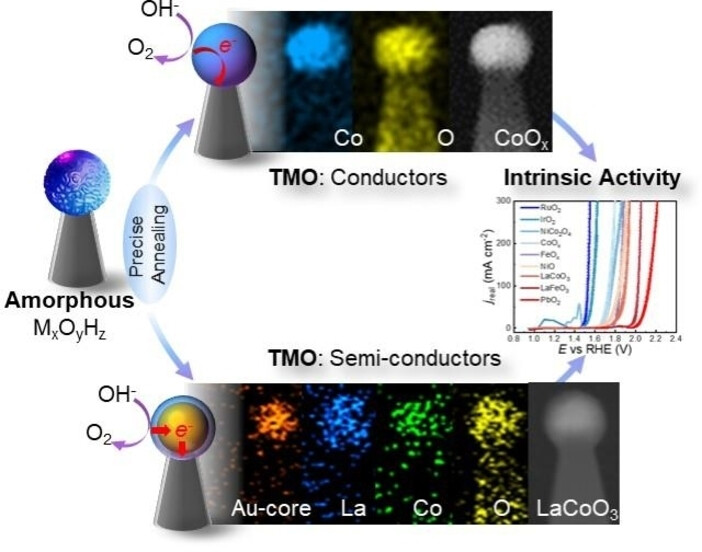
We innovatively adopted an electrodeposition-annealing method, synthesizing transition metal oxides (TMOs) single-particle nanoelectrode with well-defined structure and composition. Not only did we accurately measure their electrocatalytic activity, but we also specially designed a structure with a conductive core wrapped in a semiconductor (SEMI) shell, to support the actual evaluation of perovskite-type SEMI catalysts for oxygen evolution reaction (OER).
Polymer Chemistry
Additive Manufacturing of Micro-Architected Copper based on an Ion-Exchangeable Hydrogel
- First Published: 03 April 2024

An efficient and straightforward strategy has been developed to create intricate and dense micro-architected copper structures using an ion-exchangeable hydrogel. The resulting copper geometries showcase a minimum feature size of around 40 μm, coupled with a notable twin density, electrical conductivity, and hardness. This methodology presents an effective pathway for the fabrication of micro-architected 3D metal structures.
MXenes | Hot Paper
One-step Synthesis of Organic Terminal 2D Ti3C2Tx MXene Nanosheets by Etching of Ti3AlC2 in an Organic Lewis Acid Solvent
- First Published: 08 April 2024
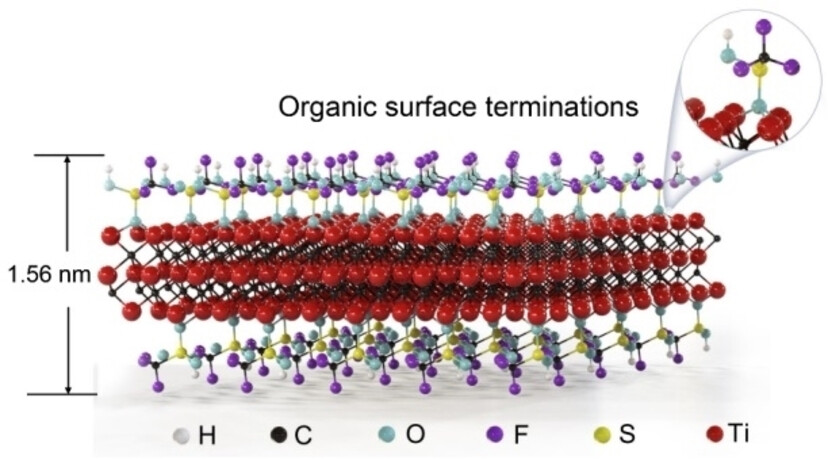
High purity Ti3C2Tx (T=−CF3SO3) nanosheets were directly obtained via an etching route using an organic Lewis acid solvent that was completely free of HF. The obtained Ti3C2Tx terminated with −CF3SO3 had large nanosheets with an average size of approximately 4 μm, the largest size reached 15 μm, and the CF3SO3− surface chemistry could generally improve the stability of the suspension.
Host-Guest Systems | Very Important Paper
Bayesian Inference for Model Analyses of Supramolecular Complexes: A Case Study with Nanocarbon Hosts
- First Published: 05 April 2024
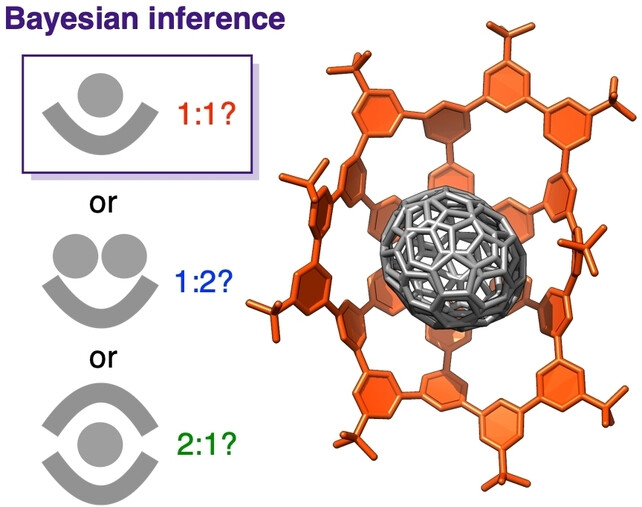
A large bowl-shaped nanocarbon molecule with 126 π electrons was synthesized, and a ball-in-bowl complex was obtained by capturing C70 at the concave site. A method for elucidating the stoichiometries in solution-phase equilibria was devised by developing a procedure to estimate the Occam factors for Bayesian inference.
Naturstoffe
Strukturrevision einer weit verbreiteten marinen Sulfonolipidklasse basierend auf deren Isolierung und Totalsynthese
- First Published: 26 March 2024
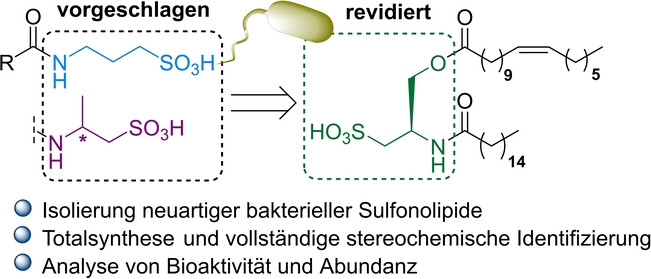
In dieser Studie konnten wir die chemischen Strukturen einer neu entdeckten Gruppe von bakteriellen schwefelhaltigen Aminolipiden (Cysteinolides) mittels analytischer Techniken, Isolierungs- und Abbauexperimente sowie ihrer Totalsynthese revidieren und ihre absolute Stereochemie bestimmen. Im Gegensatz zu früheren Strukturvorschlägen auf der Basis von Homotaurin, weisen Cysteinolide eine cysteinolsäurehaltige Kopfgruppe auf, die mit verschiedenen (α-Hydroxy-)Carbonsäuren acyliert ist.




